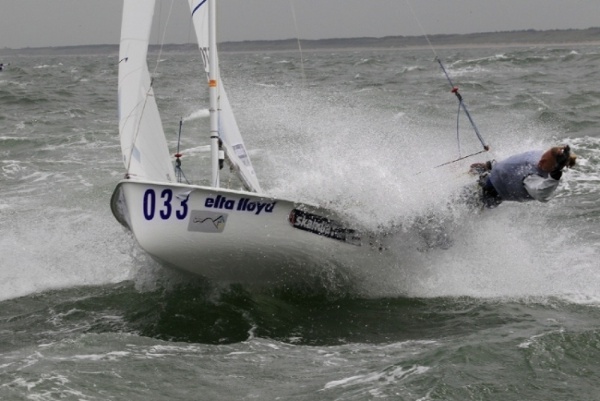

Harnessing technical, tactical and athletic performance, all in one package.
Since our first build in 1993, a Mackay built 470 has helped produce Olympic glory and world champion sailors year on year.
Find out more in the Features section below
Specifications
Hull Length 4.7
Beam Length 1.7
Mainsail Area 9.45 m2
Headsail Area 3.59 m2
Spinnaker Area 12.16 m2
Boat Weight 120 kg
Number of Trapeze Single
Year of status 1969
Type Centreboard Boat
No. of Crew 2
Opt Crew Weight 110 - 145
Hull Material GRP
The 470 is a double handed, mixed crew Olympic yacht.
470 Class Association website : http://www.470.org/
The 470 is a light and narrow boat (length 4.7m and beam 1.7m with a weight of 120kg), that responds easily and immediately to body movement.
The skipper is normally smaller and lighter (1.65m to 1.8m and 55kg to 65kg) and the crew is taller (1.75m to 1.85m yet only 65kg -75kg). The crew's build lets him or her hang far out on the trapeze to keep the boat level in all conditions.
Since our first build in 1993, a Mackay built 470 has helped produce Olympic glory and world champion sailors year on year. Over the years we have refined our knowledge on what makes this boat go fast.
Our boats have a reputation for high strength and stiffness . We focus on these two areas so that the boat will hold high rig tension and not flex in the bow and mid sections.
It also means that the tune of the boat will not change through a season of racing so that the rig tensions and mast bends will not alter as the season progresses.
In 2018 we produced a new mould which we believe is the ultimate for a mixed crew combination heading to Paris 2024.
The mould is designed to maximise the energy from body pumping while also making the boat easy to sail. It was designed with help from sailors, Nathan Wilmont and Jo Aleh, who worked alongside our navel architect, Kevin Trotter.
Part of the success with our latest design comes from adding a little bouyancy in the back of the boat which will make it easier to steer in waves and easier to catch small waves downwind. Bouyancy is also added in the front to balance the changes in the stern.
All of the ribs on our boats are vacuum clamped foam with chopped mat and uni-directional rovings on top. We obtain extra strength from the rigidity of the foam itself.
The construction techniques we use give greater longevity and therefore eliminate the need to replace the boat every year or two. We believe that our construction techniques are as advanced as allowed by the rules.
The building process also involves a considerable amount of custom workmanship. We concentrate on building fewer boats but of a very high quality. We have placed the greatest importance on workmanship, care and attention to detail.
International 470 Class History
In 1963, French architect Andre Cornu designed the two-handed centerboard boat as a modern high performance fiberglass planing dinghy which could be sailed by anyone. And the craft so influenced European sailing that the 470 is directly credited with drawing new sailors to the sport during the 1960s and '70s.
The 470 has been an Olympic class boat since 1976. It is sailed today for both family recreation and superior competition by more than 30,000 sailors in 42 countries worldwide.
In 1988, women officially entered Olympic sailing competition with the first-ever 470 Women's event. This boat is especially well-suited to women's competition because of its light weight, maneuverability and light crew weight requirement.
Click here to view more information on the history of the 470.
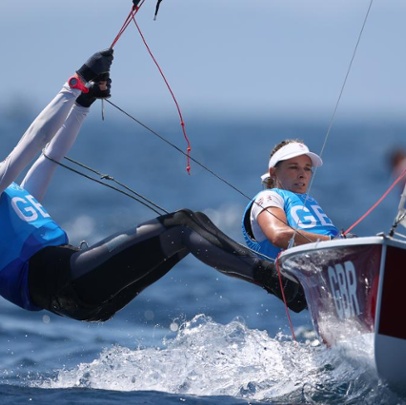
470: Recent Success for Mackay Boats
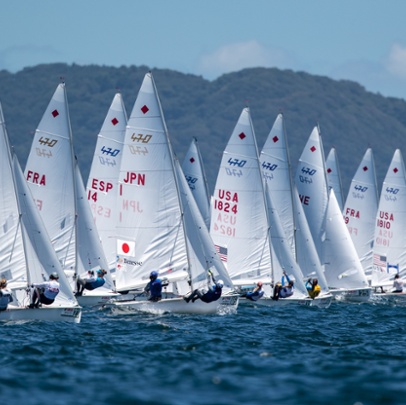
470: The history of its success
Can mackay's customise the layout of the boat.
Yes. Nearly all 470 are customised to suit your own preferences.
What can be customised?
We offer options for most control systems on the boats. Go to our 470 order form to see the options available. International 470 Package - Mackay Boats - NZL
Can you do other fitout options not on the list?
Yes. Many teams send us pictures with their own personal systems for us to copy.
What fitout options do the top crews choose?
All teams have something slightly different, but generally most top teams choose the continuous rig tension system (Option c) , the 4:1 up with 2:1 down centreboard system (Option a) and the carbon jib brackets. These are the only 2 systems that most top teams have in common.
How to do a gelcoat repair?
Small gel coat repairs are relatively easy to do.
What is Gelcoat made up of?
Gelcoat is a polyester product that is cured by using a catalyst called MEKP. (Methyl Ethyl Ketone Peroxide)
MEKP is a dangerous substance and should be treated as such when using, being very careful not to get any on your skin or in your eyes.
How can I get the catalyst - MERK?
We cannot ship MEKP so you will always need to buy it separately from your local marine store or fibreglass manufacturer.
How much MERK do I need?
The amount of Catalyst varies depending on the conditions you are using it in, but around 2%-3% will always work.
It is best to use a small syringe or dropper to get the required catalyst rate.
If you have mixed 100gm of gelcoat, then you are aiming for 2ml of catalyst.
What are the Gelcoat colours?
Gelcoats colours are not always a 100% perfect match.
Colour will vary depending on the depth of the repair and the batch.
470 White- LS30 White PA 337
470 Grey- Grey RAL 7035
Blue = is supplier by Nuplex who have their own code which is not an international code
Does Mackay Boats supply gelcoat?
We supply a small tin (of each relevant colour) with each new boat.
Order additional gelcoat from our store, although it cannot be shipped by courier.
How do I do gelcoat repairs?
Doing gelcoat repairs is an art that improves with experience.
Making sure the surface is prepared well and keyed up is critical.
Overfill and then sanding back is a slow and time-consuming process.
Be very careful not to scratch the boat around the repair.
You shouldn’t sand the original surface around the repair with any paper coarser than 600grit.
Mask around the repair to protect the boat.
You can initially use a file or 150g to take the high parts off the filling, but don't use the coarse paper for too long or you will end up with scratches in the finished repair.
Once you have it fair with 600g, you can work your way through the sandpaper grades until you finish with 1500grit before cutting and polishing.
We would typically use 600g, then 800g or 1000g, then 1200g, then finally 1500g.
How do you fit a mylar gasket to a 470?
Please watch a demonstration: Fitting a mylar gasket
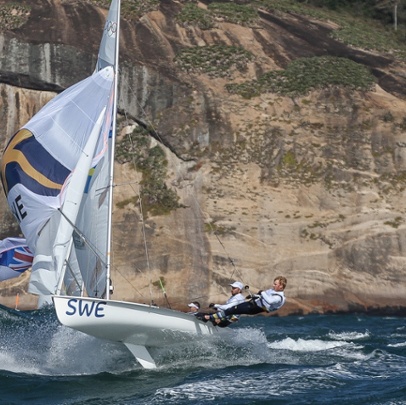
470 Tuning Tips
Are you sure you want to change currency.
- BOAT OF THE YEAR
- Newsletters
- Sailboat Reviews
- Boating Safety
- Sails and Rigging
- Maintenance
- Sailing Totem
- Sailor & Galley
- Living Aboard
- Destinations
- Gear & Electronics
- Charter Resources
- Ultimate Boat Giveaway

Boat Reviews: The Dufour 470 and Dufour 61
- By Mark Pillsbury
- March 2, 2022
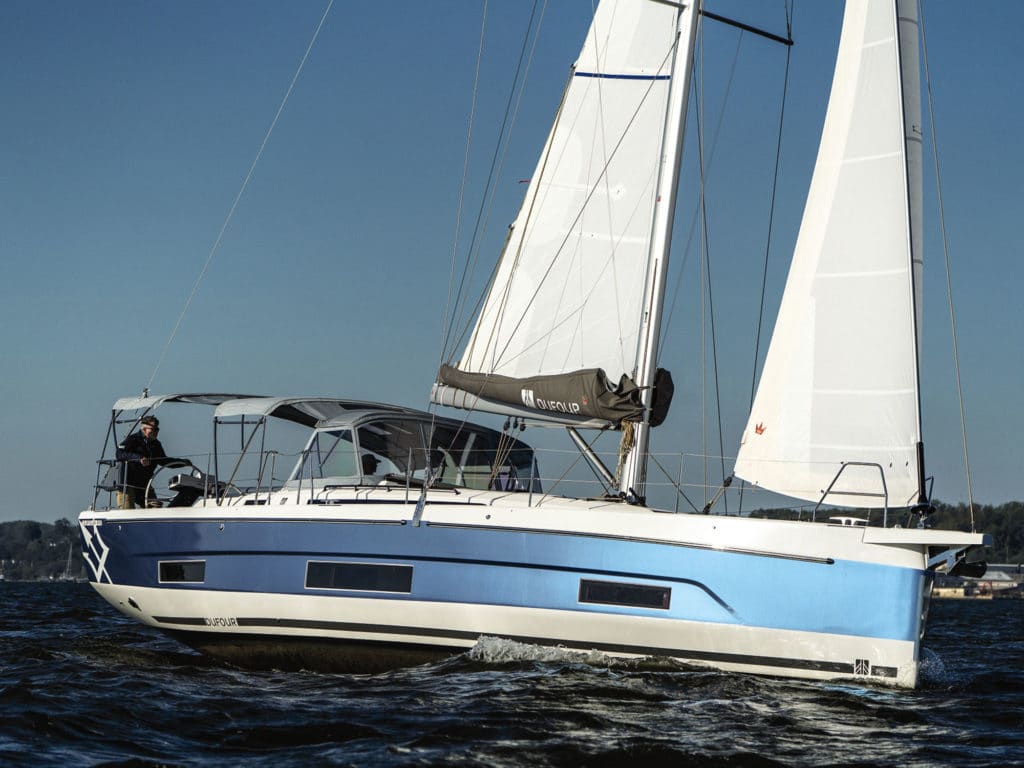
In a year disrupted by pandemic-related workforce distractions, supply-chain woes and an overhaul of its woodshop, Dufour Yachts, one of France’s most prolific sailboat builders, still managed to launch more than 350 vessels, including two new models introduced to North America during the US Sailboat Show in Annapolis, Maryland, this past October.
Making their debuts were the performance-cruiser Dufour 470 and a new company flagship, the Dufour 61. Like all Dufours built over the past two decades, the latest in the range come from the drawing board of Umberto Felci, working alongside the in-house design team. The latter now includes input from catamaran builder Fountaine Pajot, whose ownership group bought Dufour three years ago.
Over time, the result of such close collaboration has been a brand with a strong visual identity and features that tend to be introduced in one model and then incorporated into the rest of the range. At present, the Dufour lineup includes nine models, ranging in size from the yet-to-be-seen (here in the US, at least) Yacht Dufour 32 to the 61.
Some of the features introduced in recent years include a galley-forward layout, which leaves the beamiest part of the boat open for living and entertaining; self-tacking headsails as an option in place of overlapping genoas; and an outdoor galley on the transom. Several of these elements are now available on models throughout the range, and based on the other new sailboats we saw this past fall in Annapolis, they are ideas that are gaining traction with other builders as well.
But while Felci and Dufour have adopted other trendy design elements, such as chined hulls and twin wheels, they’ve steered clear of twin rudders, opting instead for a single deep foil that provides ample control while backing and sailing, thanks in part to hull forms that favor diminished angles of heel.
Discussing the brand in general terms, Boat of the Year judge Tim Murphy spoke for his colleagues, saying that during sea trials, they’ve come to expect lively sailing performance from Dufour yachts, thanks in part to sails, gear, and deck layouts that reward sailors keen on tweaking lines to control sail shape and trim.
Let’s start with the 470, which was the first boat I visited alongside the BOTY judges.
It was an easy step aboard from the dock, thanks to the wide fold-down transom that doubles as a spacious swim platform. Beneath the cockpit sole to starboard, we found an ample-size life-raft locker; to port, two steps take you past the fold-up helm seat and into the cockpit itself.
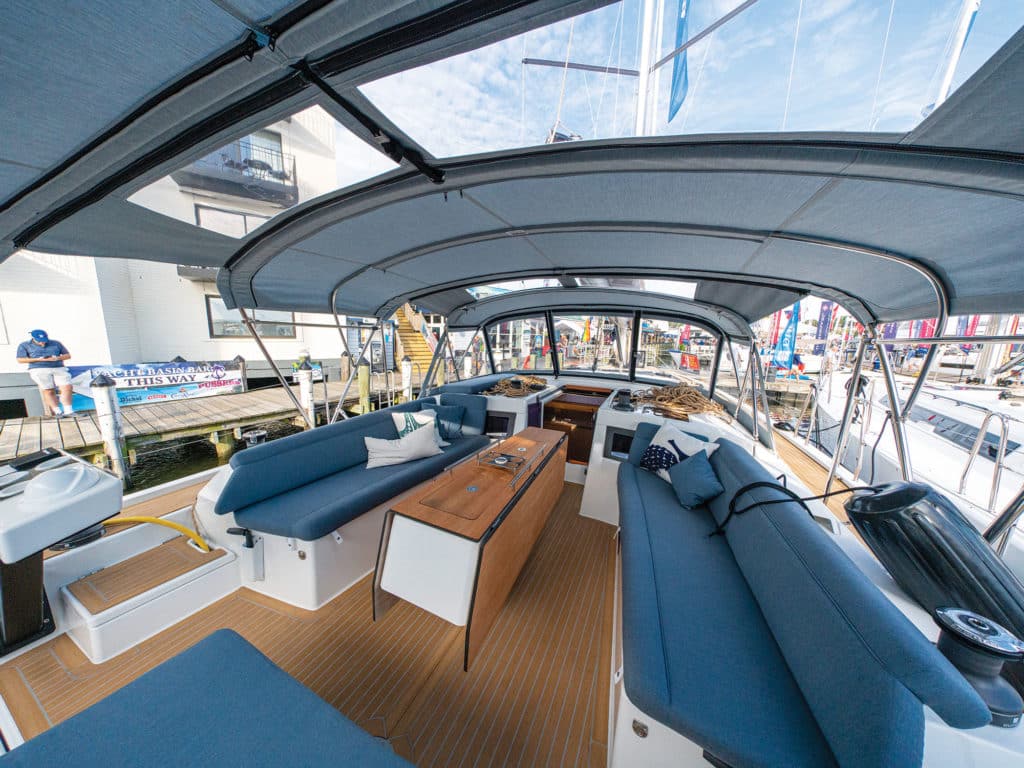
One reason for the proliferation of twin wheels these days is the wide beam that’s carried aft on many boats. Usually the space between helms is left open, but on the 470, it’s put to good use with a large padded lounge area, which I must admit looked like an inviting place to spend time off watch. It was designed so there’s still good access to the cockpit proper. And while sailing, I didn’t find it in the way when stepping between wheels that are mounted on pedestals well outboard to free up space around the drop-leaf table that sits between the cockpit settees.
Another cockpit element that I thought worked quite well are the steps up to the side deck, located just forward of each wheel. One per side, these provide a simple, neat solution to the dilemma of how to clamor over coamings to go forward, plus they double as line-storage bins for the adjacent winches.
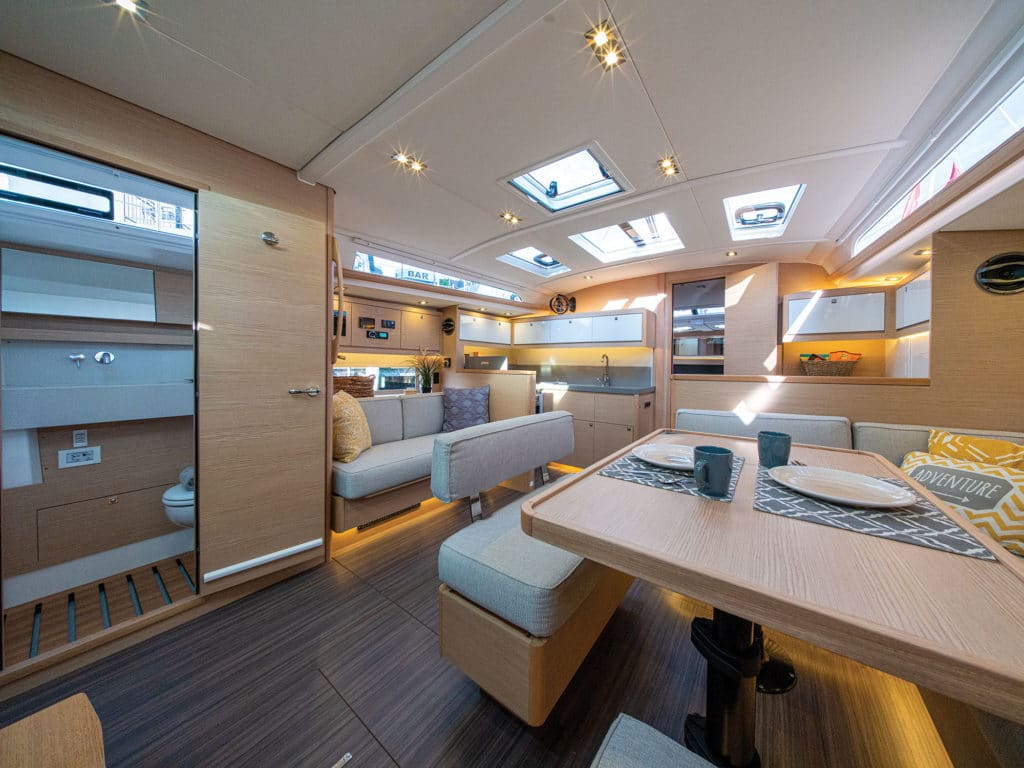
The 470, like other Dufour models, is available in three levels of gear and deck layout, depending on how an owner plans to use the boat. Easy, intended for the casual sailor or charterer, gets you a self-tending jib and in-mast furling main, both with halyards and sheets running to a pair of winches on the cabin top. The boat we toured and sailed was set up as an Ocean version, with a pair of Lewmar winches at each helm for main and jib sheets, as well as two more winches on the cabin top for halyards and sail-control lines. Our boat was fit out with a traditional main that’s stored in a boom pouch and a self-tacking jib. But fairlead tracks on the side decks also allow for a genoa; on the bow, there’s a sprit for flying off-wind sails that also incorporates an anchor roller. A beefy traveler sits just forward of the dodger, providing more control over the main.
The Performance version of the 470 includes additional sailhandling gear, plus end-boom sheeting for the main, with an anchor point in the cockpit sole just forward of the wheels. The latter two versions can also be set up with a double-ended German-style mainsheet, meaning the skipper has control of the sail at either wheel.
Down below, the 470 is available in four layouts, all with the galley forward, adjacent to the main bulkhead. Included in the design is a feature I’ve really liked on other Dufours: large overhead hatches that span the cabin top just aft of the mast and let tons of light into the interior. Accommodations span from three cabins and two heads, which we found on the boat we sailed, to four cabins and four heads, or four cabins plus a Pullman berth and three heads. As I said, there are options.
Dufour uses foam core above the waterline and solid fiberglass below in its infused composite hulls. Decks are also infused, and a composite grid is bonded to the hull before furniture and systems are installed to carry loads from the keel, engine and rig.
The 470 we sailed is available at a sail-away price right around $600,000. This includes Raymarine electronics, a bow thruster (a stern thruster is an option), and a 60 hp Volvo engine and saildrive; an 80 hp powerplant is also available.
We had a decent breeze—about 12 knots—to start with on the afternoon we went for a sail. Closehauled, the speedo hovered just under 6 knots. Off the wind on a beam reach and in less breeze, maybe 8 knots, the speed dropped to the mid-4-knot range. If I were buying the boat, I’d definitely spring for a code zero or other reaching sail to keep things lively. From either helm, sightlines forward, past the Bimini and dodger, were OK, and their frames doubled as excellent handholds when stepping onto the side decks to go forward.
Unfortunately, we sailed the 61 earlier in the day, when in a week of nearly perfect conditions, we were skunked for breeze. But powering along with the boat’s 175 Volvo with shaft drive, we scooted right along at 8.7 at the suggested cruising rpm and added another knot when we opened the throttle wide in get-home-quick mode. This hinted at what we might have seen under sail, but in less than 3 knots of breeze, we were in for nothing but drifting on a glassy bay.
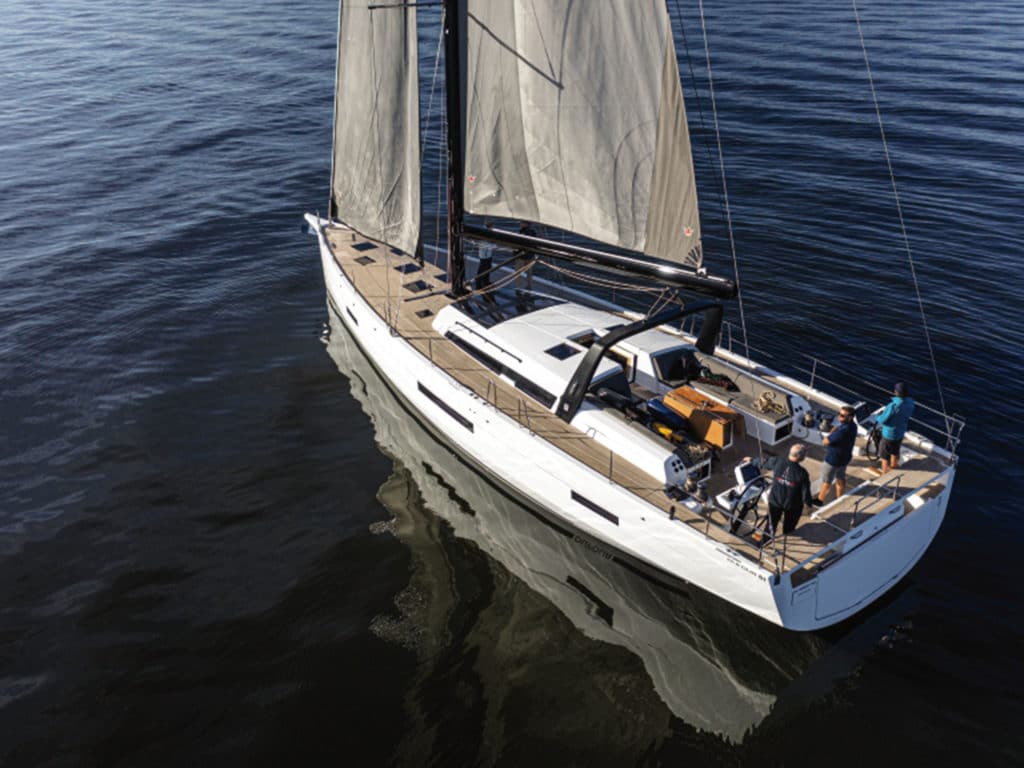
Compared with the 470 and other boats in the Dufour range, the 61 has quite a different look, especially on deck; while down below, she feels big for her size.
Rather than a Bimini and dodger, the 61’s topsides are wide open, save for a carbon-fiber arch over the companionway, on top of which the double-ended mainsheet is anchored with two blocks. This keeps the deck and coachroof free of lines when sailing.
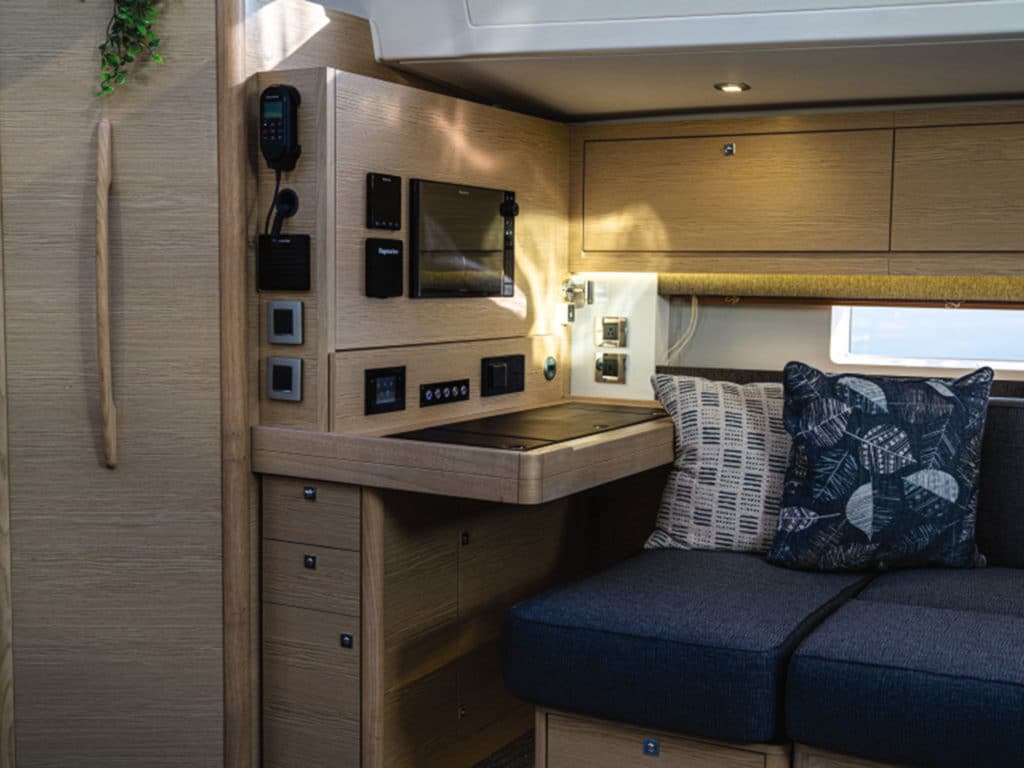
The low-profile cabin top, wide side decks, and expansive open foredeck definitely give the 61 a big-boat feel. Aft, with the swim platform down, there’s a large dinghy garage. One concern cited by the judges is that when loaded, the dinghy appears to cover the socket for the emergency tiller. Forward, there’s a large, deep sail locker, with access to the anchor chain, and with a few contortions, the motor for the below-deck electric headsail furler. The jib is self-tacking, and there are no genoa tracks or a molded place to mount them on the teak decks. As the company brochure reads, the boat was developed to provide “simple, instinctive sailing.”
Underway, all the actual work of tending canvas takes place at the twin wheels, where four electric winches give the helmsman fingertip control of all the required lines. Guests can be left to enjoy the spacious cockpit and its wide, drop-leaf centerline table with a fridge underneath.
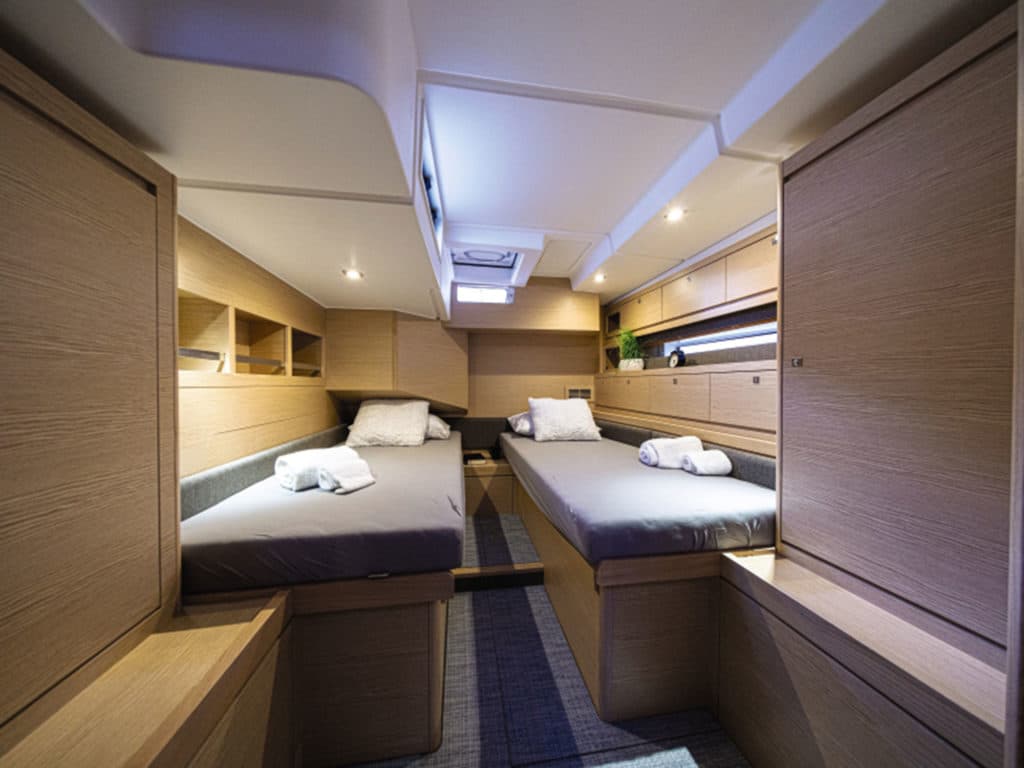
As with the 470, an owner has options below for family, guests and crew. The boat we visited had twin aft cabins; a Pullman berth with bunks to starboard, opposite the forward galley; and a unique owner’s cabin far forward that caught my eye, with a queen berth offset to port, and a head and shower compartment forward. Locating the galley aft, to port of the companionway, is also possible, as are a couple more sleeping-cabin layouts, providing berths for up to eight crew, plus a captain’s berth in the forepeak.
The 61 comes with a flagshiplike price tag of right around $1.3 million for a boat loaded up and ready to go. But thanks to the span of the Dufour range, an owner who appreciates the brand can start smaller and work themselves up to the 61, a few feet at a time.
Specifications
| LENGTH OVERALL | 48’9″ (14.86 m) |
|---|---|
| WATERLINE LENGTH | 45’10” (13.97 m) |
| BEAM | 15’6″ (4.72 m) |
| DRAFT | 7’5″ (2.26 m) |
| SAIL AREA (100%) | 1,151 sq. ft. (106.9 sq. m) |
| BALLAST | 8,160 lb. (3,701 kg) |
| DISPLACEMENT | 29,101 lb. (13,200 kg) |
| BALLAST/DISPLACEMENT | 0.28 |
| DISPLACEMENT/LENGTH | 135 |
| SAIL AREA/DISPLACEMENT | 19.5 |
| WATER | 140 gal. (530 L) |
| FUEL | 250 gal. (946 L) |
| ENGINE | 60 hp Volvo, saildrive |
| DESIGNER | Felci Yachts Design |
| PRICE | $600,000 |
| LENGTH OVERALL | 63’1″ (19.23 m) |
|---|---|
| WATERLINE LENGTH | 60’1″ (18.31 m) |
| BEAM | 16’5″ (5 m) |
| DRAFT | 9’2″ (2.79 m) |
| SAIL AREA (100%) | 1,829 sq. ft. (169.9 sq. m) |
| BALLAST | 14,330 lb. (6,500 kg) |
| DISPLACEMENT | 53,279 lb. (24,167 kg) |
| BALLAST/DISPLACEMENT | 0.27 |
| DISPLACEMENT/LENGTH | 110 |
| SAIL AREA/DISPLACEMENT | 20.7 |
| WATER | 226 gal. (855 L) |
| FUEL | 232 gal. (878 L) |
| ENGINE | 175 hp Volvo |
| DESIGNER | Felci Yachts Design |
| PRICE | $1,300,000 |
Dufour Yachts 240-278-8200 dufouryachts.com
- More: Best Luxury Cruiser , Best Performance cruiser , Boat of the Year 2022 , print 2022 march , sailboat review , Sailboat Reviews , Sailboats
- More Sailboats

Sailboat Preview: Elan GT6 Explorer

For Sale: 1984 Camper & Nicholsons 58

Alubat Updates OVNI Models

For Sale: Little Harbor 63 Ketch

From Paradise to Medical Emergency: A Bahamas Nightmare Turns Lesson Learned

Free Medical Advice: The Unwarranted, Unprofessional Edition

Gatekeepers of the Waterway

Rigging Redo: Our Switch to Synthetic
- Digital Edition
- Customer Service
- Privacy Policy
- Terms of Use
- Email Newsletters
- Cruising World
- Sailing World
- Salt Water Sportsman
- Sport Fishing
- Wakeboarding
- New Sailboats
- Sailboats 21-30ft
- Sailboats 31-35ft
- Sailboats 36-40ft
- Sailboats Over 40ft
- Sailboats Under 21feet
- used_sailboats
- Apps and Computer Programs
- Communications
- Fishfinders
- Handheld Electronics
- Plotters MFDS Rradar
- Wind, Speed & Depth Instruments
- Anchoring Mooring
- Running Rigging
- Sails Canvas
- Standing Rigging
- Diesel Engines
- Off Grid Energy
- Cleaning Waxing
- DIY Projects
- Repair, Tools & Materials
- Spare Parts
- Tools & Gadgets
- Cabin Comfort
- Ventilation
- Footwear Apparel
- Foul Weather Gear
- Mailport & PS Advisor
- Inside Practical Sailor Blog
- Activate My Web Access
- Reset Password
- Customer Service

- Free Newsletter

Ericson 41 Used Boat Review

Mason 33 Used Boat Review

Beneteau 311, Catalina 310 and Hunter 326 Used Boat Comparison

Maine Cat 41 Used Boat Review

Tips From A First “Sail” on the ICW

Tillerpilot Tips and Safety Cautions

Best Crimpers and Strippers for Fixing Marine Electrical Connectors

Thinking Through a Solar Power Installation

Polyester vs. Nylon Rode

Getting the Most Out of Older Sails

How (Not) to Tie Your Boat to a Dock

Stopping Mainsheet Twist

Fuel Lift Pump: Easy DIY Diesel Fuel System Diagnostic and Repair

Ensuring Safe Shorepower

Sinking? Check Your Stuffing Box

The Rain Catcher’s Guide

What Do You Do With Old Fiberglass Boats?

Boat Repairs for the Technically Illiterate

Boat Maintenance for the Technically Illiterate: Part 1

Whats the Best Way to Restore Clear Plastic Windows?

Giving Bugs the Big Goodbye

Galley Gadgets for the Cruising Sailor

Those Extras you Don’t Need But Love to Have

What’s the Best Sunscreen?

UV Clothing: Is It Worth the Hype?

Preparing Yourself for Solo Sailing

How to Select Crew for a Passage or Delivery

R. Tucker Thompson Tall Ship Youth Voyage

On Watch: This 60-Year-Old Hinckley Pilot 35 is Also a Working…

On Watch: America’s Cup

On Watch: All Eyes on Europe Sail Racing

Dear Readers
- Sailboat Reviews
Catalina 470
Although it conforms to ce ratings for ocean sailing, this boat is better suited for coastal cruising in comfort and short offshore passages. it's got a great set of layout options for living aboard..

We’ve been soaked to the bone while racing Catalina’s most popular model, a 27-footer on which we crewed in a San Francisco one-design fleet. We’ve raced down the Baja coast steering a squirrelly 38-footer under a masthead kite while winning class honors in the Newport-Ensenada race. Over the years, we’ve sailed and reviewed quite a few Catalinas, and have noted two central characteristics of these boats: They have a pretty good turn of speed and spacious accommodations. We’ve also noted that the company’s mass production techniques occasionally reflect a lack of attention to detail in the fit and finish of joinery.
It has also been impossible to miss the fact that Catalina owners are a ferociously loyal lot who tend to shrug off minor shortcomings by saying “Hey, it ain’t supposed to be a Rolls Royce.”
With the introduction of the Catalina 470 in 1998, the company announced an effort to upgrade the quality of the fit and finish without changing its pricing practices. It also added a legitimate performance cruiser to dealer showrooms. More than 200 of these boats have been delivered already. That’s an amazing production run for a boat of this size in an economy this wobbly. Price-wise, Catalina can keep competing when other, higher-end boatbuilders are startting to duck and cover.
Company History Frank Butler, who founded Catalina Yachts 30 years ago, has always contended that his boats provide owners with good value, and this is true. The company’s product line spans the sailing universe; it offers boats ranging in size from the Capri 22, a daysailor, to the 47-footer described here.

Mindful of the occasional barb about quality control, Gerry Douglas, Catalina’s vice president, chief engineer, and Butler’s right-hand man for two decades, says, “Our owners don’t mind adding that extra layer of varnish. They’re very hands-on, and like to tinker on their boats. I like to think that we’ve given them a stable platform on which they can safely sail anywhere at an affordable price.”
While conducting an inspection and test sail of the 470, Douglas said, “We’ve gone up a notch with this boat, and introduced features that we’ll begin adding to all of our boats 38 feet and longer. There’s also a higher level of sophistication in systems, construction, and finish.
“We designed the boat to appeal to fairly experienced sailors who are comparison shoppers. For many, this will be a crossover boat—for people moving up from 40-footers, and people switching to Catalina from other brands. The typical buyers are 55 to 60 years old, perhaps semi-retired. They want performance, to cruise under sail, not power. They have a wish list with regard to accommodations. Systems are very important.”
Design/Appearance Overall, the hull is nicely proportioned, with a nearly flat sheer that runs to the down-curved stern sections. The 14-foot beam is moderate for a modern 47-footer, and runs well aft, almost to the transom area. This adds some initial stability as well as interior volume aft. The straight sheerline works well with the house, which carries long, narrow ports to produce an illusion of movement. Though she carries huge interior volume, she does not appear clunky.
According to Gerry Douglas, the hull is easily driven with the moderate sailplan, and doesn’t pound in a seaway. We weren’t able to sail her in lumpy enough conditions to confirm that, but she did behave well during our test sail.
Underbody appendages are a 7’10” fin keel or optional shoal draft keel with winglets 30 percent aft of the leading edge. Rudder and keel are elliptically shaped.
“A cockpit should be long enough to sleep in,” says Douglas. As a consequence, seats in the 470 cockpit are 6’2″ inches long, with 11″ backrests. The 39″ long cockpit table seats four, and has a built-in storage bin and molded cup holders.
Unlike any other arrangement we’ve seen, the electrical system for shore power is split between three separate connectors. According to Douglas, this is “so that owners can use smaller cords than those heavy, unwieldy brutes.”
Deck Layout The deck layout is designed for couples who prefer to sail alone without having to maintain a physical fitness routine in order to manage the 1,010 square feet of canvas she flies. Most boats are equipped with furling mainsail systems and oversized electric winches for halyards and mainsail controls. “I don’t think we can have too large a winch,” Douglas says.
Add the Dutchman sail flaking system that comes as standard equipment, and the boat could even be singlehanded in a pinch.
The layout of deck gear is typical of the today’s production boats and the fact that older sailors don’t want to work forward of the cockpit in unruly seas. Internal halyards and sail controls are led aft to Harken 44 two- speed winches and Lewmar rope clutches. Primary winches are Harken 66 two-speed self-tailers.
Catalina continues to rely on Garhauer to provide most of the boat’s blocks, as well as a stainless steel vang. The roller furler is a Schaefer 3100. Standard equipment also includes a Maxwell 1200 windlass.
In addition to contributing to the boat’s appearance, ten Lewmar ports, including two in the cockpit, allow light and fresh air to penetrate spaces belowdecks. Deck hatches are Lewmar low-profile Ocean series.
Despite the boat’s size, and potential use on blue water, the double- spreader rig is stepped on deck. To avoid damaging the deck coring, it sits atop a 1/2″ thick aluminum plate welded to the top of a 5-1/2″ inch diameter compression post. “It’s all metal to metal,” Douglas says.
It’s true that there are plenty of boats with deck-stepped masts sailing successfully offshore, including the Hallberg-Rassy 42, which we reviewed in May of this year. Every time we say we prefer keel-stepped masts for offshore work, we get angry letters—not from the boatbuilders, but from readers who have deck-stepped masts. So be it. We believe keel-stepped masts are ultimately safer, even if they’re noiser, leakier, and more obtrusive belowdecks. Offshore, if something fails, they’re less likely to topple over wholesale—the “buried root” tends to preserve them—and if they do break, they usually leave something sticking through the deck to which a jury rig can be attached. As we noted in the HR42 review, the butt of a keel-stepped mast needs to be secured to the step.
From the standpoint of comfort and safety, handrails recessed below the cabintop prevent bruised legs when the crew is seated without impairing their ability to find a handhold. Three pre-molded indexes under the boom are designed to house an eight-person life raft in a handy, out of the way location. Stanchions are 29″ high, and shroud bases are set in close to the cabintop, which allows close sheeting angles and makes travel between cockpit and foredeck easier.
On boats this size, Douglas considers redundancy in major systems a key element of the design. As a result, the two-wheel steering system is a product of a collaboration between Catalina and Edson. “The entire system is redundant,” says Douglas. ” There are no shared cables or wheels. Each steering wheel has a separate cable system, so if one is lost the other will still function.”
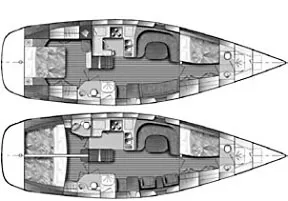
Accommodations Though there’s nothing earthshaking about the general design of spaces belowdecks, the 14-foot beam produces 11 feet of room amidships, continuing Catalina’s tradition of maximizing living spaces.
Improvements in the quality of the interior are subtle. Multiple layers of smooth satin varnish are hand-laid on wood surfaces. The edges of cabinetry, doors and corners, where wear or abrasion may be noticeable, are made of solid teak to prevent blemishes. Lockers and cabinets are fitted with lights that automatically turn on when doors open. Since Catalina now builds cushions in-house, berths are supplied with 7″ thick residential-grade mattresses with powder-coated springs that prevent rust marks on bedding. All of the cabinetry hardware is provided by one company, so replacement of damaged equipment is a small task.
Owners can select stateroom layouts from three optional configurations. In the standard two-stateroom configuration, the forward cabin houses a Pullman berth and shower compartment in an area large enough to house a washer and dryer combination. Aft is a queen-sized bunk on an island. As an alternative, layout No. 2 splits the aft section of the boat into two cabins, each with its own head compartment. An island berth in the forward cabin is an option in this configuration. The third layout offers the option to remove cabinetry from the port stateroom to convert the space into an enclosed workshop. Nice idea!
Headroom in the saloon is 7′ 4″, and length on the centerline approximately 11′ 6″. Seven ports on each side of the hull, and 11 Halogen lights in the saloon and galley, produce a bright space, even on foggy day.
Seven companionway steps cover the engine. Since the cover is a bulky fiberglass box with an aluminum frame, the addition of a gas piston spring that holds the section upright is a helpful addition. Once that’s elevated, access to the sides and front of the Yanmar engine, fuel and water filters, is excellent.
“To prevent contamination, and monitor consumption, boats are equipped with two separate fuel systems and five water tanks,” says Douglas. “If one goes bad, no more than 20 percent of the supply will be lost. There are two independent waste systems. Tanks, hoses, and through-hulls operate independently.”
Though the boat is not intended for use in a charter fleet, tanks are thick enough to meet charter regulations. “We did that because it would be more difficult to change in the future.”
Creature comforts in the main cabin include a C-shaped settee with seating for six to eight adults around a highly polished table. Stowage below the settee is in a watertight compartment, eliminating the risk of bilge water penetrating stores.
Depending upon owner preference, seating to starboard may be on a 6′ 6″ bench with space below for 50 gallons of fuel, or on two upholstered swiveling chairs.
On a boat of this size, there should be plenty of room for the navigator, and Catalina does a good job in this regard. The 470 is equipped with a proper chart-sized table and room for electronics. Forward of the nav table there’s a slide-out table for a TV/VHS combination, radio, and Sony CD changer, all of which are standard equipment. Circuit breakers on the electrical panel are illuminated—a real plus after sunset.
It’s axiomatic that bigger boats have bigger galleys, and the 470 is no exception. Located to port, it offers a chef plenty of elbow room, counter space, and a portlight outboard that provides a view. Counters are constructed of Grancoat®, a tough fiberglass material that’s easy to maintain. A dry locker that could be converted to a refrigerator is located outboard to port, and a cabinet with glass doors is located on the aft bulkhead. The stove is a three-burner Princess with oven and a stainless steel hood fitted with halogen light. A microwave stored in a cutout will accelerate prep time of hot drinks for the midnight watch crew.
In all, living quarters are spacious and well-organized, and fit and finish are a cut above her predecessors.
Construction This Catalina is built at the company’s Florida factory. A completed boat consists of four components: the hull; a structural grid liner that absorbs and diffuses chainplate and mast loads and houses the engine bed; a liner running from bow to stern that does not provide any structural support but forms furniture, beds and cabinets; and, finally, the deck.

The hull to a point 6″ above the waterline is solid fiberglass impregnated with vinylester resin in the skin coat. The lamination schedule calls for hand-laying 2-oz. chop and 8 layers of mat and roving to produce a 1″ thick bottom. Topsides are cored with Baltec AL 600 balsa. A collision bulkhead at the aft end of the anchor locker fills the area between the deck and bottom of the hull; it is glassed to the hull.
The deck is constructed of layers of chop, mat, and roving cored with 1/2″ thick balsa. Pre-tapped, 3/8″ thick aluminum plates are bedded in areas where deck hardware will be installed.
Chainplates also show a new design, not used on any other Catalina models. Says Gerry Douglas, “It’s a ball- and-socket arrangement that locates chainplates through a round hole in the deck, rather than a slot. This method spreads loads, and they are perfectly bonded so there’s no problem with leaks. They are also self-aligning.” (Leaky chainplates have been a common source of criticism for Catalina yachts.)
Despite being a relatively complicated boat, most wiring and plumbing runs are easily accessible under floorboards and seat covers, and color coded for identification. Wiring runs are in half-round PVC bonded to the hull. A 118-page owner’s manual provides schematics of all of the boat’s mechanical systems, and should help to make most things clear even to those who may be “mechanically challenged.”
Performance Invited aboard by Douglas and Seattle dealer Carl Rafello, we tested the 470 on a fall afternoon in which predicted 10-15 knot winds did not materialize. However, we did ferret out the 470’s personality in 6-8 knot winds. In that light air she performed well enough to sneak into our definition of “performance cruiser,” although that phrase is amorphous enough to include a lot of boats in different conditions.
Her rated sail area of 1,010 square feet (100% foretriangle), combined with her wing-keel configuration displacement of 26,500 lbs., gives her a SA/D ratio of 14.01—in the lower ranges of what we might hope for in the horsepower department. Change to a fin keel and she immediately drops 1,800 pounds of displacement; add the optional taller rig for sailing in predominately light winds, and SA increases to 1,092 square feet. This combination allows a SA/D of 18.9, a much more blood-stirring figure. In that configuration, the D/L drops to 160, and she actually ends up in the upper reaches of the light-displacement category.
Sailing with the standard rig and fin keel under a 135-percent genoa, we recorded 5-6 knots of boatspeed off the breeze. Upwind, when pressed, she could sail within about 40 degrees of the apparent wind without loss of speed. Our upwind and downwind boatspeeds were about the same in that breeze. The helm is light, sight lines from both wheels are excellent, and our test boat tacked easily through about 90 degrees.
The limit of positive stability (LPS) of the 470 is listed at 126 degrees, which is within the acceptable range for offshore boats, and in fact she’s rated as a Category A (“Ocean”) cruiser under CE requirements. While we don’t doubt the boat’s essential structural integrity, or that she could cross an ocean in the right hands, she’s really not set up for that. (For example, aside from the mast issue, there are no sea berths, which might be OK on a downwind sail to Hawaii, but wouldn’t be too great on a long starboard tack to Bermuda.)
Conclusion Our test provided, at best, a hint of the performance potential of this boat. Nonetheless, given proper conditions we would expect her to sail at her calculated hull speed of 8.5 knots.
A prospective buyer must carefully evaluate typical conditions in the area where the boat will be sailed, and match sail area and keel configuration accordingly. The deep-keel, tall-rig combination will certainly maximize the boat’s performance. (Those are big jumps in both SA/D and D/L numbers up there.) Given deep enough home waters, this would be the way to go. With that set-up, we could expect her to record 150-200 mile days off the wind under a cruising kite.
Well-conceived mechanical systems make the 470 easy to sail. Be aware, though, that there are of lot of these systems, from the dual steering to the rather complex lighting and entertainment wiring. The harder you sail this boat, the more scrutiny and maintenance these systems will require.
In terms of creature comfort, the boat is excellent—spacious on deck and gracious below. Her list of standard equipment is extensive; add electronics and a 150% genoa, and stores, and she’ll be ready for a coastal cruise. Add electric winches and a mainsail furling system, and the task becomes easier (although more complicated).
Following the company’s philosophy, the 470 is moderately priced at $265,510 (FOB Largo), in the ballpark with similarly sized production boats like the Beneteau 473, priced at $231,000. (Close scrutiny of the list of standard gear is necessary for a complete comparison of pricing.)
The strengths of the 470 lie exactly where Gerry Douglas placed them for his potential market: She’s set up very intelligently for coastal cruising, living aboard, and the occasional coastal hop of a few hundred miles in offshore conditions. That’s plenty to ask of a production boat of this size and price, and the 470 seems to answer those demands nicely. She also comes with a devoted support network of owners.
Contact- Catalina Yachts, 818/884-7700, www.catalinayachts.com .
RELATED ARTICLES MORE FROM AUTHOR
Leave a reply cancel reply.
Log in to leave a comment
Latest Videos
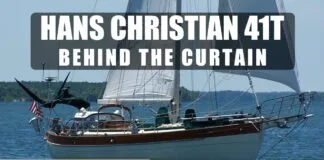
Hans Christian 41T – Boat Review

Seven dead after superyacht sinks off Sicily. Was the crew at...

What’s the Best Sailboats for Beginners?

Why Does A Sailboat Keel Fall Off?
Latest sailboat review.

- Privacy Policy
- Do Not Sell My Personal Information
- Online Account Activation
- Privacy Manager
Great choice! Your favorites are temporarily saved for this session. Sign in to save them permanently, access them on any device, and receive relevant alerts.
- Sailboat Guide
470 is a 15 ′ 5 ″ / 4.7 m monohull sailboat designed by Andre Cornu and built by Fountaine Pajot, Mader Bootswerft, Parker Yachts, MacKay Boats Ltd., and Nautivela starting in 1963.

Rig and Sails
Auxilary power, accomodations, calculations.
The theoretical maximum speed that a displacement hull can move efficiently through the water is determined by it's waterline length and displacement. It may be unable to reach this speed if the boat is underpowered or heavily loaded, though it may exceed this speed given enough power. Read more.
Classic hull speed formula:
Hull Speed = 1.34 x √LWL
Max Speed/Length ratio = 8.26 ÷ Displacement/Length ratio .311 Hull Speed = Max Speed/Length ratio x √LWL
Sail Area / Displacement Ratio
A measure of the power of the sails relative to the weight of the boat. The higher the number, the higher the performance, but the harder the boat will be to handle. This ratio is a "non-dimensional" value that facilitates comparisons between boats of different types and sizes. Read more.
SA/D = SA ÷ (D ÷ 64) 2/3
- SA : Sail area in square feet, derived by adding the mainsail area to 100% of the foretriangle area (the lateral area above the deck between the mast and the forestay).
- D : Displacement in pounds.
Ballast / Displacement Ratio
A measure of the stability of a boat's hull that suggests how well a monohull will stand up to its sails. The ballast displacement ratio indicates how much of the weight of a boat is placed for maximum stability against capsizing and is an indicator of stiffness and resistance to capsize.
Ballast / Displacement * 100
Displacement / Length Ratio
A measure of the weight of the boat relative to it's length at the waterline. The higher a boat’s D/L ratio, the more easily it will carry a load and the more comfortable its motion will be. The lower a boat's ratio is, the less power it takes to drive the boat to its nominal hull speed or beyond. Read more.
D/L = (D ÷ 2240) ÷ (0.01 x LWL)³
- D: Displacement of the boat in pounds.
- LWL: Waterline length in feet
Comfort Ratio
This ratio assess how quickly and abruptly a boat’s hull reacts to waves in a significant seaway, these being the elements of a boat’s motion most likely to cause seasickness. Read more.
Comfort ratio = D ÷ (.65 x (.7 LWL + .3 LOA) x Beam 1.33 )
- D: Displacement of the boat in pounds
- LOA: Length overall in feet
- Beam: Width of boat at the widest point in feet
Capsize Screening Formula
This formula attempts to indicate whether a given boat might be too wide and light to readily right itself after being overturned in extreme conditions. Read more.
CSV = Beam ÷ ³√(D / 64)
2 person centerboard class with trapeze. An Olympic class since 1976. Separate events for men and women since 1988. The 470 is sailed in more than 60 countries. Spinnaker: 140 sq. ft. 1 Trapeze.
Embed this page on your own website by copying and pasting this code.
- About Sailboat Guide
©2024 Sea Time Tech, LLC
This site is protected by reCAPTCHA and the Google Privacy Policy and Terms of Service apply.
The Worldwide Leader in Sailmaking
- Sail Care & Repair
- Sailing Gear
- Find A Loft
- Sail Finder
- Custom Sails
- One Design Sails
- Flying Sails
- New Sail Quote
- 3Di Technology
- Helix Technology
- Sail Design
- NPL RENEW Sustainable Sailcloth
- Sailcloth & Material Guide
- Polo Shirts
- Sweaters & Cardigans
- Sweatshirts & Hoodies
- Accessories
- Shop the look
- Mid & Baselayers
- Deckwear & Footwear
- Luggage & Accessories
- Fall Winter '24
- North Sails x 37th America's Cup
- Sailor Jackets
- SALT X North Sails
- NS x Slowear
- T-shirts & Tops
- Sailor Jacket
- Sustainability
- North Sails Blog
- Sail Like A Girl
- 37th America's Cup
- Icon Sailor Jacket
- Our Locations
- Certified B Corporation
- North SUP Boards
- North Foils
- North Kiteboarding
- North Windsurfing
SAIL FINDER
SAILING GEAR
COLLECTIONS & COLLAB
COLLECTIONS
WE ARE NORTH SAILS
ACTION SPORTS
Popular Search Terms
Organic cotton
Scuba fleece
Drawstring hood
Utility pocket
Stand collar
Sorry, no results for ""
Subscription
Welcome aboard.
We want to make our emails as relevant as possible for you.
Interests saved
Something went wrong, please try again
Welcome to North Sails
Stay up to date with the latest North Sails news.
Receive a 10% discount code for your first apparel order. Excludes sails and SUP’s. See our Terms and Conditions .
Yes, I agree to the terms of use and privacy policy.
470 SPEED GUIDE BY SÎME FANTELA
Who sails the 470.

What does it take to be successful in the 470?
Who does what on the boat, what are the keys to rig set-up, what are the keys to rig tuning.
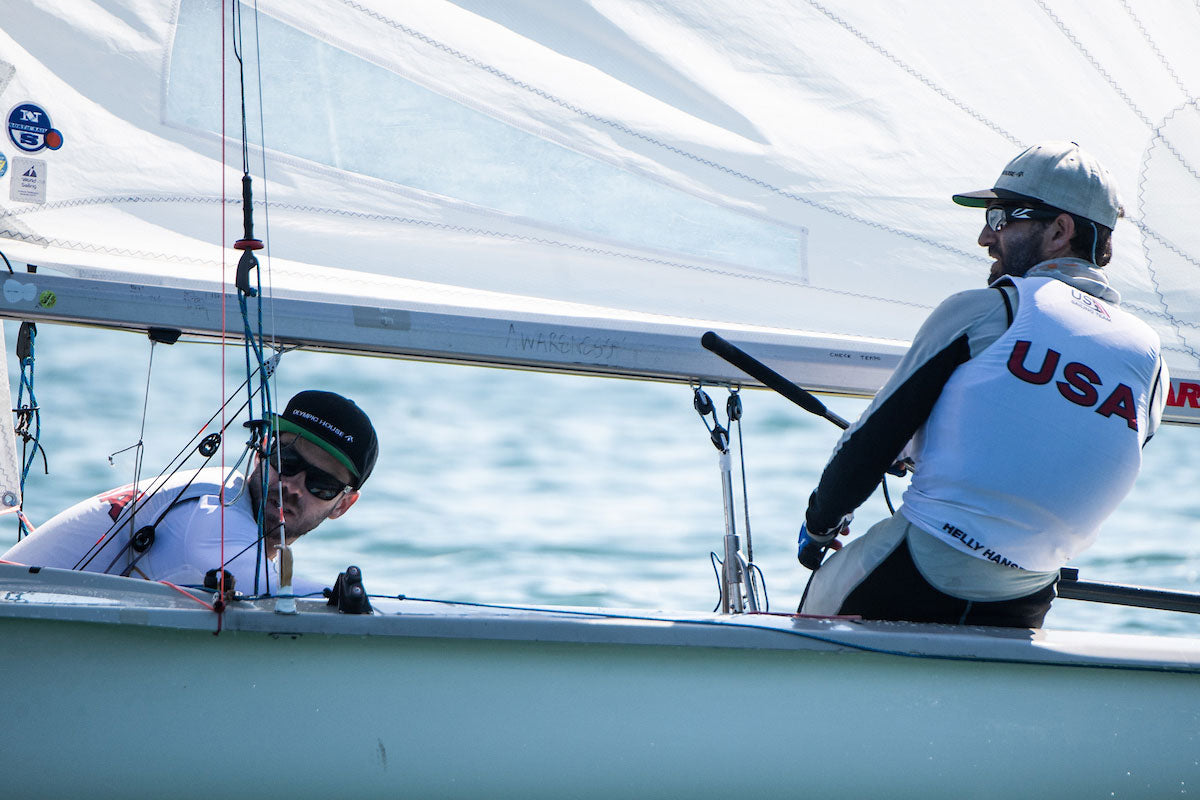
Upwind Sailing
Where does each person sit on a 470 in light air, what are the key changes in different conditions, what do you focus on when trimming the 470 main, what do you focus on when trimming the 470 jib, what are the key adjustments to make when wind and sea state increase, any other advice about gear changing in a 470, what's the typical conversation between 470 helm and crew.
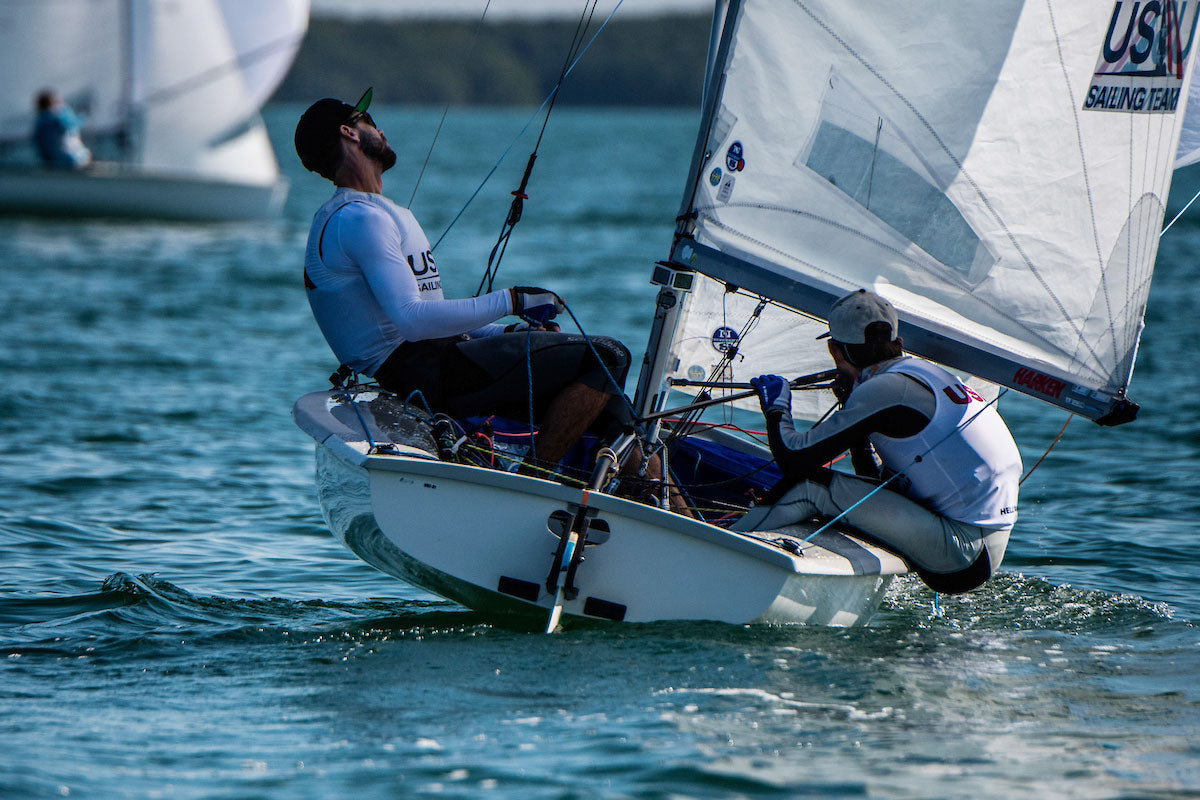
Downwind Sailing
What 470 spinnaker would you recommend, where does each person sit in a 470 downwind, what are the key adjustments to make sailing downwind, what’s the most important thing about 470 trimming downwind in light air, what’s the most important thing about 470 trimming downwind in heavy air, what is a typical conversation downwind.
- What mode do we want to achieve (high and fast, or low and slow)?
- Is the Oscar flag up so we are allowed to pump?
Any special considerations to sail the 470 well downwind?

Boat Handling
Top three tips to starting a 470 well.
- Try to keep the flow on the rudder and centerboard as long as you can. Once you lose that, it can take some time to attach again.
- Always fight for space down to leeward. If you don't have enough, you're not going to survive the first 100 meters.
- Identify the last possible moment for a double tack. And whether you double-tack or not, know the right time for good acceleration and the right exit angle.
Any tips for 470 downspeed boat handling?
What is the most common mistake when tacking a 470, what does each person do in a tack, key tip for good light-air tacks in a 470, key tip for good heavy-air tacks, key tip for good light-air jibes, key tip for good heavy-air jibes, what’s the best way to set a 470 spinnaker who does what.
- Come in off the trapeze wire.
- Take the spinnaker tack out of the spinnaker bag with one hand, while pulling on the windward barber-hauler/twing with the other hand.
- Hook the pole to the sheet, topping lift, and mast - Jaws up!

What’s the key to a good 470 spinnaker takedown?
Personal Tip: We always have a windward takedown, because we have a storage bag on each side of the boat.
Doing a 720 penalty turn is slow. What are the keys to minimizing the pain?
How easily does the 470 broach or capsize, how do you recover from a 470 capsize, what are the most common boat helming mistakes made in the 470 class, any suggestions for drills to improve 470 boat handling.
GET IN TOUCH
REQUEST A QUOTE
BROWSE ALL SAILS
FIND YOUR SAIL
Featured stories, 37th america's cup preview with ken read, meet the fresh faces of america's cup design, the long life of a north sail.
- Refresh page

470 sailboat and trailer

15.5 foot 470 Olympic class sailboat for sale. Manufactured in 1973. Includes main, jib, and spinnaker with spinnaker pole and trapeze harness. Recently renovated. Good condition. Includes galvanized trailer. Have PA title for trailer and PA registration for the boat.
Sailboat Details
Boat measurements, list of equipment, contact listings owner form, seller information.

Related Listings
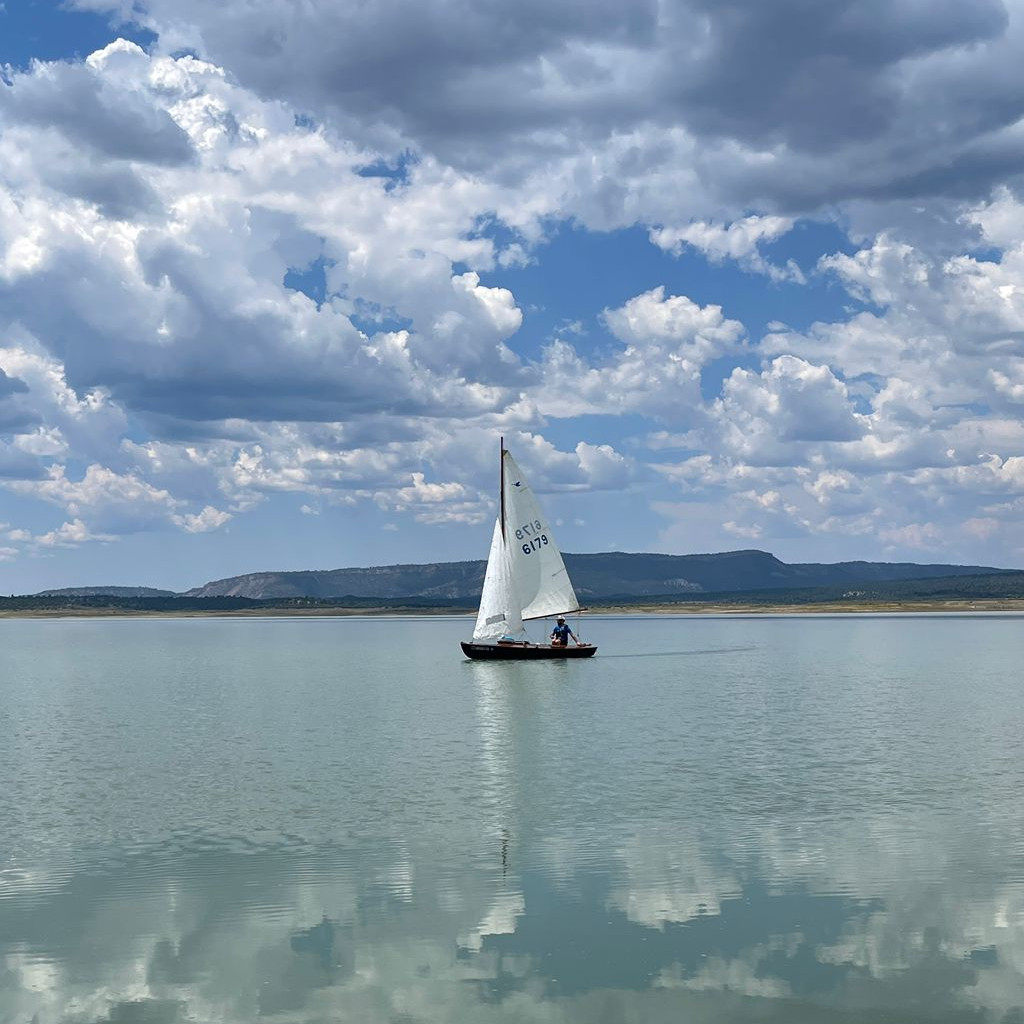

1946 Snipe, beautifully restored wood dinghy
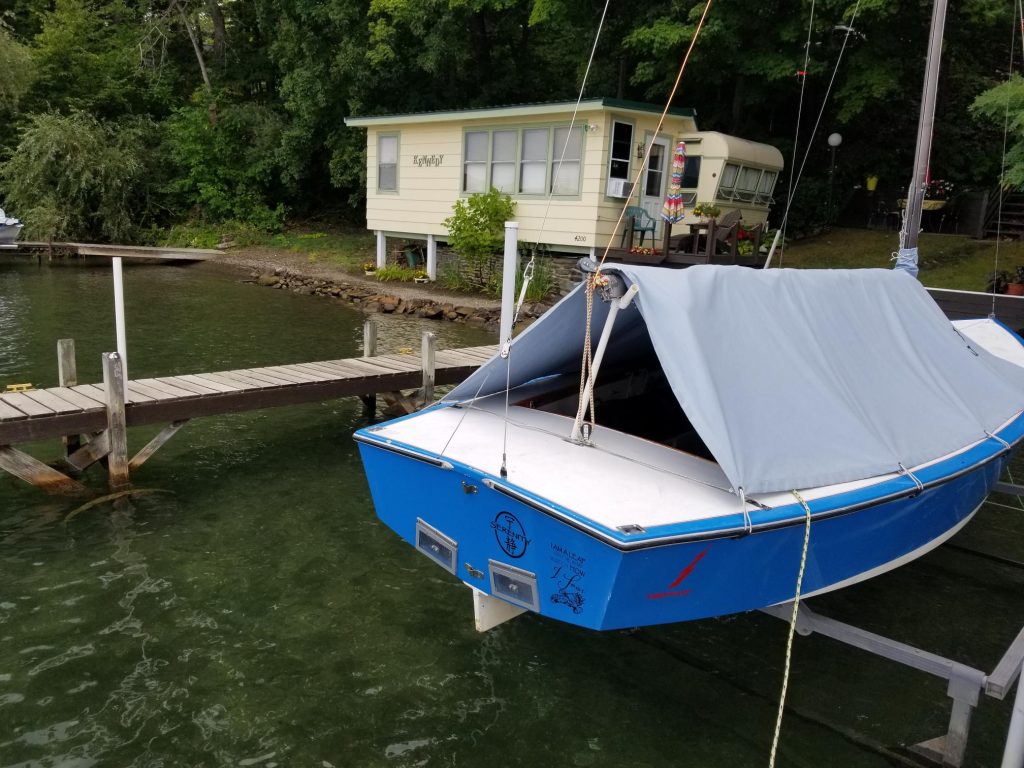
Lippincott Lightning
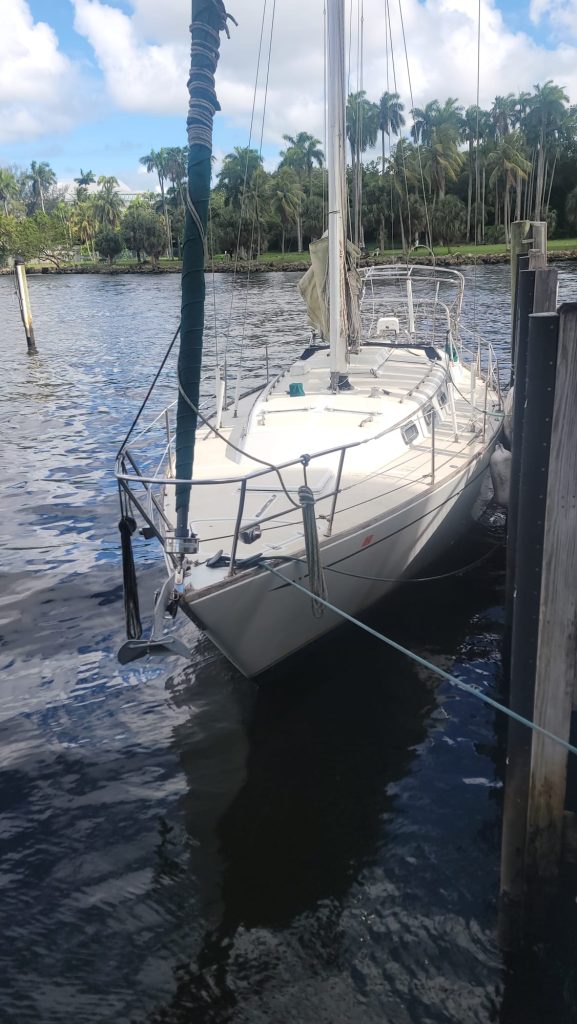
Cal-Pearson Sloop 39
The Sailor’s Marketplace for Sailboats and Sails.
Sell Your Sailboat
Sailboats for sale.
- New Sailboats
- Used Sailboats
- Cruising Sailboats
- Racing Sailboats
Sell Your Sails
Sails for sail, sail manufacturers.
- North Sails
- Quantum Sails
- Doyle Sails
- UK Sailmakers
Sailing Reviews
- Sailing Line
- Safety Equipment
- Sailing Accesories
As an Amazon Associate SailTrader earns from qualifying purchases.
This website uses cookies to ensure you get the best experience possible.
US 470 Class Association
Class contact information.
Click below
Class Email
Class Website
One-Design Class Type: Dinghy
Was this boat built to be sailed by youth or adults? Both
Approximately how many class members do you have? 35
Photo Credit:
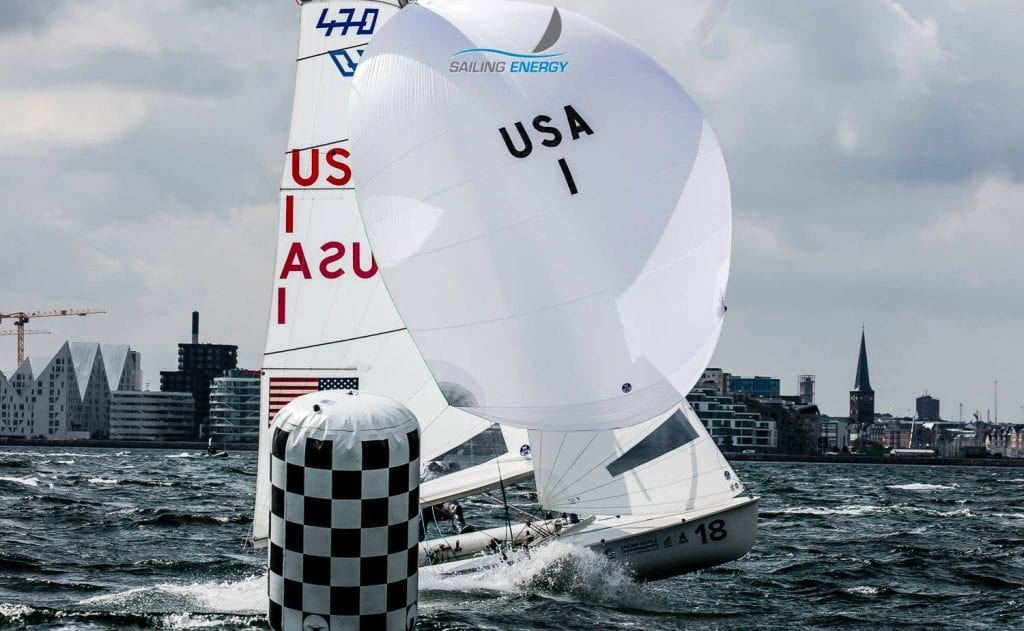
Photo Credit: Will Ricketson, US Sailing Team
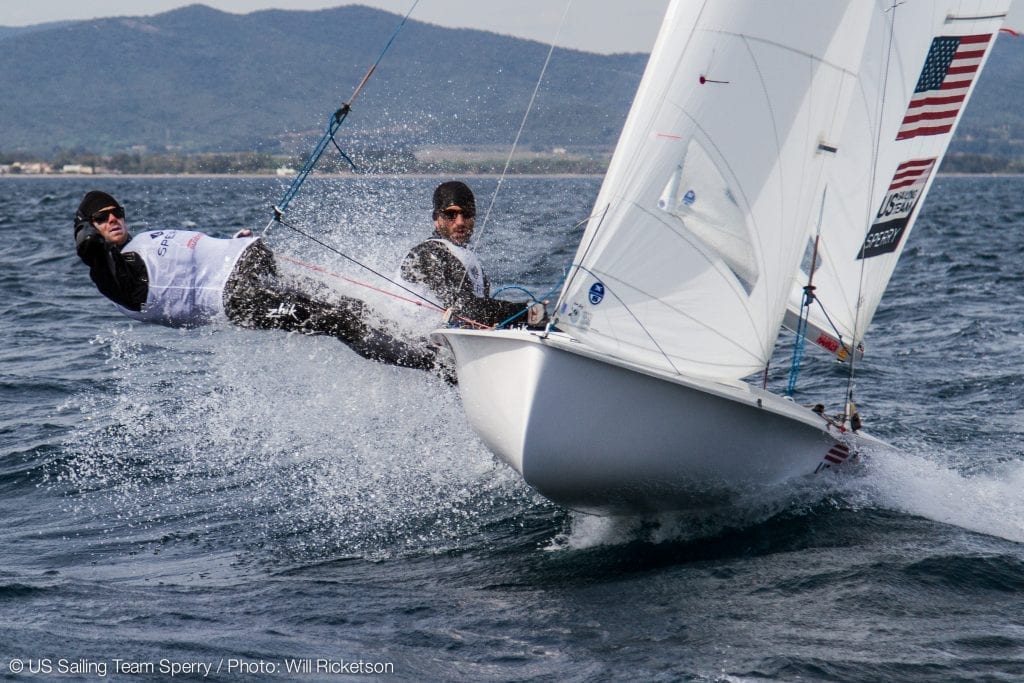
About US 470 Class Association
Olympic equipment of choice for the men’s and women’s two-person dinghy – representing the world of two-person spinnaker sailing at the Olympics. The 470 has been raced at every Olympics since 1976. In 1988, a women’s event was added. For the 2024 Olympics, the 470 will revert to mixed.
Boats Produced: 34,500
Class boat builder(s):
Mackay Boats (NZL), Ziegelmayer (GER), Sports Center (POL), Yamaha (JPN)
Approximately how many boats are in the USA/North America? 100+/-. 1850+/- registered all time in the USA.
Where is your One-Design class typically sailed in the USA? List regions of the country:
Miami, FL; Newport, RI
Does this class have a spinnaker or gennaker? Yes
How many people sail as a crew including the helm? 2
Ideal combined weight of range of crew: 300+/-
Boat Designed in 1963
Length (feet/inches): 4.7m
Weight of rigged boat without sails: 120kg
Draft: 0.1m
Mast Height: 7.2m
Back to One-Design Central
Copyright ©2018-2024 United States Sailing Association. All rights reserved. US Sailing is a 501(c)3 organization. Website designed & developed by Design Principles, Inc. -->
Sailboat Cost Calculator
With this calculator, you can quickly calculate your ownership cost based on up-to-date sailboat price data from our yearly research.
Select boat
Select the boat length and condition:
| Length | New | Used |
|---|---|---|
| 15-19ft | $24,000 | $8,000 |
| 20-24ft | $50,000 | $19,000 |
| 25-29ft | $96,000 | $30,000 |
| 30-34ft | $183,000 | $66,000 |
| 35-39ft | $251,000 | $111,000 |
| 40-44ft | $326,000 | $150,000 |
| 45-49ft | $400,000 | $162,000 |
| 50-60ft | $654,000 | $281,000 |
| 80-100ft | $5,889,000 | $1,534,000 |
One-time costs
Select which of the following line items you'll need:
Recurring costs
Access our detailed calculator.
This calculator will help you get underway by making your sailing dream actionable. It's a lightweight version of our full calculator that is part of our paid Sailing Dream Calculator Suite, which you can get here .
Detailed ownership costs
Each year, we compare thousands of sailboat listing prices to come up with reliable average prices of sailboats. This calculator uses the most up-to-date data. If you want to read a more in-depth exploration of sailboat ownership costs, I recommend you read our guide.

How Much Sailboats Cost On Average (380+ Prices Compared)

How Much Is a Sailboat? (Average Cost of Buying & Owning)

Last Updated by
Daniel Wade
June 15, 2022
You've probably spent an afternoon at a busy marina, right? And whether you've sailed with a crew or are simply attracted to the leisurely lifestyle of sailing along the coast, being the proud owner of a sailboat is a dream of many. But what is the average cost of buying and owning a sailboat? This comprehensive guide will help you understand the realities of buying and owning a sailboat.
If you've spent time on a friend's sailboat or enjoyed a few weekends with a sailboat rental, you certainly know that having your sailboat can be an incredible experience. Having your own sailboat can give you the freedom to enjoy sailing, exploring, fishing, and watersport while creating fun memories with friends and loved ones. If anything, sailing is an activity that you can indulge in and enjoy anytime you like.
Most of us have been told that you need "Mt. Everest" sort of money to own a sailboat. This is just a widespread misconception that can take the wind out of your sails, so to speak, before you even hit the waters. Although owning a sailboat does cost money, it's quite affordable than most people think.in addition to the cost of buying your sailboat, there are other costs and expenses to consider. It only makes sense that you know all the costs involved in boat ownership so that you come up with a better plan and budget.
So what's the average cost of buying and owning a sailboat? The price of owning a sailboat may vary depending on several factors such as the size of the sailboat, its model, whether it's new or used, and how often you use the sailboat. For example, a new Islander 36' can cost nearly $150,000 while a used one can cost you around $40,000. Again, the price of a new 26' Catalina can cost you around $80,000 while a used one can cost you about $20,000. The annual maintenance cost can range between $2,000 and $3,000 for most boats while the total annual costs can be somewhere between $3,000 and $7,000.
In this comprehensive guide, we'll show you all the costs you've ever wanted to know when it comes to buying and owning a sailboat. This will at least ensure that you spend less time worrying about the costs of owning a sailboat. Instead, you'll spend more time having fun, exploring the world, and having fun with friends and family.
Table of contents
The Initial Purchase Cost
The most obvious cost involved in buying a sailboat is the initial purchase cost. The price of the boat will vary depending on a few factors such as the type of the boat, the size, whether it's new or used, its condition, and many more.
In most cases, buying a used boat is a lot cheaper than buying a brand new boat. Keep in mind that buying a brand new boat is almost comparable to buying a brand new car. You'll not only pay a huge premium but its value will depreciate immediately after you buy it. More importantly, you should first consider the types of activities you want to use the boat for and how often you'll be hitting the waters.
When buying a used boat , the rule of thumb is to prudently look for a 2 to 10-year-old boat. This is a great way of saving on the initial purchase cost. You should, however, check if it's in perfect condition. For example, you should get an expert to check the viability of the hull, drivetrain, and even the engine if it has any.
If you don't have enough cash to buy a sailboat outright, you can consider various financing options that are available out there. You can either choose to use your bank of a specialized marine lender. Keep in mind that factors such as your income, credit rating, and the value of the boat may be considered. These options can make boat ownership quite affordable, though you may have to pay some down payment.
Normally, brand new boats will come with warranties but this may not be the case when buying used boats, especially from an individual. You should, however, make sure that you get a warranty of some kind to cover you in case of anything negative. You should ask for maintenance logs and receipts for parts or repairs.
Buying a Brand New or a Used Sailboat
In addition to the typical costs of owning a boat such as maintenance and mooring, which we will discuss later, buying a brand new or a used sailboat come with potential hidden charges. They include:
Surveying or Inspection Cost - It's generally advisable that you have the boat inspected before purchasing it. This, of course, is crucial whether you're buying a brand new boat or a used boat. So in addition to the cost of buying the boat, you should also have inspection fees that could be around $1,500 for inspection fees and around $800 for the survey.
Buying a boat without proper inspection can be detrimental especially if it turns out that the boat is in bad condition. It would be really short-sighted on your part to buy a boat without proper inspection especially if you take into account the fact that marine mechanics are very complicated and costly. Normally, inspection should be carried out by a profession but here are some of the things to look at.
- Check the sails, batteries, and the engine
- Pull out the dipstick and check the engine
- Check the boat's hull
- Make sure that the safety gears of the boat are in tip-top condition
Even though pre-purchase boat inspection can be grueling especially if you're looking at many different boats, it's of great importance if you do not want to waste your hard-earned money by purchasing a lemon. You should, therefore, always consider paying for a thorough and professional inspection even if it means you'll lose $1,500 and end up not buying the boat.
With that in mind, you should be prepared to pay for inspection whether or not you'll make the final decision to purchase the boat. For instance, you can carry out an inspection, get unsatisfied, and choose not to buy the boat. In such a scenario, you'll be short of $1,500 and still walk home without a boat.
Add-ons - Generally speaking, a boat should come with essential add-ons such as sails, anchors, life jackets, and rigs. But what if the particular boat that has captured your attention doesn't have this essential add-on? Well, you may have to go into your pocket and buy these add-ons. However, make sure that you use such add-ons to negotiate for a lowered price.
Depreciation - Needless to say, the cost of a brand new boat will depreciate immediately after you buy it. In other words, it's not possible to sell the boat at the same price at which you bought it.
Although it's generally said that the value of a boat depreciates quickly after purchase, it's quite difficult to predict the rate of such depreciation. Figures will, of course, vary depending on various factors such as the style and age of the boat. To give you a rough idea, new boats may lose around 40-50% of the initial purchasing cost in the first 8 or 10 years.
This depreciation rate will reduce about 5% annually after 10 years, though the condition of the boat may have a significant bearing on the value of the boat. You may have to replace things such as the sails, electronics, batteries, and canvas after every 5 years. But with proper care and maintenance, these parts can last longer and save you from unexpected expenditures.
Moorings and Storage of the Boat
The cost of mooring your boat may vary based on the nature of the marina, the facility, and the region. However, it's easy to quantify these costs, even though you'll have to do some considerable legwork if you want a budget-friendly option. You can easily find a mooring costing about $500 for a 30ft boat but the same space can cost well over $6,000 in prime locations.
In addition to working within a budget, the most important thing is to ensure that your boat is securely moored or stored, especially against pilings, banging, spillage, or breaking free. Without this, you could end up having to deal with avoidable repair costs.
Insurance, Registration, and Taxes
Insurance is not a major expense, particularly when compared to other costs. In fact, it's relatively cheaper and should be a problem. The cost of insuring a boat will depend directly on the value of the boat. Generally, the insurance cost maybe about 1.5% of the boat's value. For example, if the value of your boat is $30,000, the insurance cost may be about $450. Believe it or not, the insurance cost of your boat is a lot cheaper than the insurance cost of the car despite the significantly lower value of the car.
In terms of taxes, this may vary depending on your state. For example, South Carolina charges about 10.5% of the boat's yearly value while Rhode Island has no boat tax. The registration cost may also vary from state to state but may cost about $250.
Maintenance Costs and Repairs
Just like any automobile, owning a boat comes with monthly and yearly maintenance costs. The costs may, however, vary depending on the type of the boat, its size, the rate of use, and your geographical region (such as saltwater and freshwater).
Needless to say, a new boat will cost a lot less in terms of maintenance than a used boat. There are engine maintenance costs, hull maintenance, winterizing, rigging inspection, sail assessing, and many more. Generally, the yearly maintenance cost can be 10% of the boat's value. For example, maintaining a boat worth $30,000 would be $3,000 per year. You may also have to consider some unexpected repair costs in case there's unplanned damage on your boat.
Operating Expenses
There will, of course, be operating expenses every time you run your boat. For example, you'll have to fuel the boat if you aren't planning on using the free winds to sail. On top of the fuel costs, there are other costs but this may depend on the type of your boat. For example, you may have to buy fuel additives to eradicate ethanol problems if your boat has a carbureted engine. If your boat uses some sort of electricity, you may want to consider expenses such as electricity bills.
So how much should you budget for operating expenses? This may be difficult to say as it can vary greatly. It may depend on the amount of time you spend on the water and how often you go sailing. It's, however, advisable to budget beforehand to at least have an idea of what to expect.
15 Popular Sailboats and How Much They Cost
While there are a lot of great sailboats out there that can be quite affordable, others can be very expensive. But even with that, there are a lot of great boats that are affordable and can serve you well. Let's look at these 15 popular sailboats and how much they cost.
1) Catalina 30 ($18,000)
Depending on the year of production, a Catalina 30 can cost around $18,000. Having been around since 1972, the Catalina 30 is known for its great performance both when racing and cruising. This is a boat that will never let you down when sailing or racing. Well, that's because it brings forth a perfect blend of comfort, durability, and speed. If anything, buying a Catalina 30 would mean that you're the proud owner of one of the most popular sailboats of all time.
The Catalina 30 is very affordable and comes fairly equipped as a very basic but reliable boat, though you can significantly improve its functionality if you customize it. There are so many Catalina 30s in the globe that it shouldn't be a problem finding one that suits your budget in terms of the initial purchase cost and maintenance cost.
But like with any boat, you should be willing to compromise when it comes to certain features. However, you can significantly improve it if you spend some amount on improving it. All in all, a Catalina 30 is one of the most affordable and easy to maintain boats in the world.
2) Islander 36 ($22,000 and above)
Built from 1971 to 1985, the Islander 36 was and remains one of the longest-lived 36-footers in the U.S. market. With over 1,000 units built during that period, this was a sailboat that was designed by the widely revered Australian boat designer, Alan Gurney. It's possible to find a worthy Islander 36 for $22,000 or slightly above that. This is perhaps because it goes against the normal norm of using a balsa deck. Instead, the Islander 36 is designed with plywood, which increases weight and elegance but can be prone to rot.
In the past, the Islander 36 looked conservatively modern given that it had a flattish appearance. But by today's standards, the Islander 36's hull is very ideal for both racing and cruising. It has a moderate beam and perfectly carried aft so that it doesn't squat excessively even when the boat is fully loaded.
This is a boat that is easy to sail single-handedly, especially with an autopilot. It has superb speed and points well into the wind. It also offers plenty of space and the utmost fun when sailing in windy conditions. In terms of maintenance, the Islander 36 is made with very durable parts that make it a lot easier to maintain. It also has one of the best values, especially if you want it for coastal sailing.
3) Contessa 32 ($30,000-$50,000)
Designed in 1970 by David Sadler and Jeremy Rogers, the Contessa is a very capable and larger alternative of the Contessa 26. With over 750 units built, the Contessa 32 remains one of the most popular cruiser-racer sailboats of all time so it's not a surprise that its cost can be quite hefty.
This is a seaworthy vessel that's superb for offshore voyages even when the weather seems to be extreme. In other words, the Contessa 32 has become widely revered thanks to its ability to endure rough seas and harsh weather. That's not all; a Contessa 32 will never disappoint you in a race.
In essence, the Contessa 32 is a great boat that will give you the confidence of sailing far and wide even single-handed. This is an incredible upwind boat that's impeccably behaved and easy to maneuver, though it can be a bit difficult to handle when sailing downwind. If you own a Contessa 32, you'll never crave anything else as it's durable, easy to maintain, and will serve you across generations.
This is not just another fiberglass boat. It's a great boat that may seem expensive given its initial cost but has unmatched curricula vitae. This is a worthy sailboat that means that you'll be joining a cult of the few.
4) Pearson 34 ($14,000-$30,000)
Pearson is one of the well-known producers of sailboats in the world. Since the 1980s, the Pearson 34 has been magnificently sailing the blue waters thanks to its superb sails, electronics, and equipment.
This is, without a doubt, a real eye-catcher that's highly comfortable for day sailing, weekends, and extended voyages. In terms of pricing, the Pearson 34 is fairly priced though it may seem quite expensive when compared to most sailboats on this list. However, that may not be true especially if you consider the many features that come with the Pearson 34.
This is a sailboat that can be easily handled by two people, which is one of the main reasons that it remains competitive in the market today. This boat has plenty of room but has some shortcomings such as small tankage of 22 gallons. Its 6 foot daft can also be an issue but this isn't an issue in a keel version.
In short, the Pearson sails are great and are easy to handle though you'll have to make sure that it's perfectly maintained, which can be quite costly.
5) Nordic 40 ($130,000 and above)
Designed by Robert H. Perry, the Nordic 40 is thus far the biggest and the most expensive boat on our list. This is an excellent offshore sailboat that's willing to take on many challenges with a special aura.
In addition to being quite roomy, the Nordic 40 has a deep-draft fin keel that gives it a superior windward ability. It has large fuel tanks and fresh water tanks that will ensure that you're sufficiently fueled for your voyages.
This is a thoughtfully designed sailboat that should offer the utmost comfort for your bluewater escapades. It will allow you to confidently cruise through your chosen grounds with ease while turning heads. Given that it's a pretty large boat, you should be prepared for some hefty maintenance costs. All you have to do is make sure that you take good care of it if you're lucky enough to find one to purchase.
In short, the Nordic 40 should be in excellent condition at all times. Make sure that the sails are in top condition and upgraded at all times. If you want to enhance your sailing experience, make sure that the interior is also upgraded to modern standards. All in all, this is a gem that you'd be very lucky to call yours.
6) Peterson 44 ($73,500-$230,000)
Designed by Doug Peterson for Jack Kelly Yachts in 1976, the 44 is a dedicated cruiser that can sail perfectly in any type of wind. With only 200 units built, finding this unbeatable sailboat is quite difficult but not impossible. For those who have owned it, they have nothing but lots of praise for this moderate-displacement blue-water design.
With a low-profile center cockpit, the 44 remains an eye-catcher not just physically but also aesthetically. The long-fin keel with a cutaway forefoot and after-body is essential in reducing wetted surface. The 44 is easy on the helm with a servo-pendulum wind vane that makes handling quite controllable. It's even much better if you use autopilot with many owners reporting that heaving-to with a reefed main and staysail set is the best option, especially in heavy weather.
30 years since it debuted, the 44s still play the seas. Ask any owner of this beauty and he/she will tell that the boat's performance is impressive and among the best. Both Jack Kelly and Doug Peterson were from San Diego and many of these units were sold on the West Coast.
Today, this is a classic that many owners are very proud of. This is a fine sailboat that was designed for long voyages given its ample accommodation and comfort. It is also more solid and very dependable.
7) Nor'Sea 27 (Less than $30,000)
This 27-footer sailboat designed by Lyle Hess is one of the most ocean-capable and quite affordable sailboats that are still in production today. This is a very compact sailboat that can be moved safely and easily by trailer from one area to another or across any ocean.
Do not get duped by its small and compact size; this is a very solid sailboat that can withstand even the worst of weather conditions. In addition to a lapstrake fiberglass hull, this boat has sturdy bulwarks, a full keel, and a round stern that gives it the utmost seaworthiness.
The Nor'Sea should just be evaluated in terms of features. It should also be evaluated in terms of its sailing performance and comfort too. This is a versatile boat that is of high quality. It is a tight little boat that is spacious and can be easily transported. The cost of the used models may vary considerably but this may depend on the age of the boat, condition, and quality of finish. Given that this is one of the most transportable boats, it will be sold together with a trailer. As such, you shouldn't overlook the cost of replacing a trailer as it can cost as much as $9,000. So if you need an affordable and compact boat to circumnavigate the globe, the Nor'Sea 27 may be a good option.
8) Cal 34 ($19,000-$30,000)
Designed by Bill Lapworth, the Cal 34 is a beautifully balanced boat that will make sailing quite delightful. This is a very dependable boat that has a solid reputation not just for its rugged design but also for its incredible sailing characteristics.
Although Lapworth was not the inventor of light-displacement cruiser-racers, he puts his stamp on this design. This is one of the most successful sailboats that have had various configurations from 1966 to 1979. This model has an enviable reputation as one of the best-designed sailboats in the industry. Its performance is superb and can mix with the best racers even though it's typically a cruiser.
It has various extras that make it safe and comfortable. For example, this boat comes with a cockpit cushion, sound system, outboard, and superb ground tackle. This is, without a doubt, a worthy sailboat that will serve you well for many years to come as long as you maintain and service it properly.
According to owners, the Cal 34 requires a good breeze to get it moving. This is because it has a trapezoidal fin keel that brings a more wetted surface than most modern fin keelboats. It has a lot of efficient features such as better sail handling layout, efficient rig. Wheel steering, diesel engine, anchor locker, a more useful interior layout, and bigger water capacity.
When buying an older model, keep in mind that most parts are now obsolete and can be difficult to find. So if the boat is not properly maintained, you may find yourself a boat with hard-to-find parts.
9) Catalina 38 ($25,000-$75,000)
With its reputation, it is not surprising that the owners of the Catalina 38 agree that sailing windward is like sailing on rails while it does magnificently well in light air. Debuted in 1978, this racer-cruiser was designed by Sparkman & Stephens. Although it's currently out of production, there are about 365 units built from 1978 to 1990.
Down below, the Catalina 38 is designed molded hull liner and teak trims and veneers like the ones used in drawer facings, doors, and bulkheads. Like most boats designed as IOR warhorses, they tend to be unstable downwind and this is a major drawback that you should consider when buying the 38. To deal with this, you shouldn't overpower or sail it extremely hard given that it's unstable and can topple over.
As a recreational keelboat built mainly of fiberglass, the Catalina 38 has nurtured loyal following with many owners praising its design, quality, and performance. This is a classic boat that's rare and considered some sort of vintage, so you'll be very lucky to get your hand on it. All in all, the Catalina 38 will perform consistently and magnificently for many years to come provided that you're lucky to get your hands on one of them.
10) Hunter 33 ($55,000-$95,000)
Although the Hunter 33 originally debuted in 1977, there's a new model that was introduced in 2011. This new model doesn't have the old-fashion features of the original Hunter 33 but is selling quite well given that it's devoted to pursuing innovations. In addition to being quite modern, this is an affordable (by its standards) boat that combines ease of handling, comfort, and incredible performance. This is a model that seems determined to make sailing less complex and more fun.
Despite such an overall impressive quality and performance, you can purchase the Hunter 33 for less than $100,000. More importantly, the boat is solid on the water. The hull is solid and is strengthened to ensure that it doesn't suffer from any impact. Thanks to its upgraded quality construction, excellent design features, and comprehensive standard gear package, it's very likely that the Hunter 33 is on its way to becoming another bestseller from one of America's well-known boat brands.
11) Tayana 37 ($34,000)
The Tayana 37 has a real love story that may be so captivating to any boat lover. This boat was done in the 1970s by Robert Perry who is still considered as arguably one of the most prolific boat designers to ever grace the world. When designing the Tayana 37, Perry wanted it to be a cruising sailboat with a more traditional touch in terms of appearance and features.
The Tayana 37 was, therefore, designed with a moderately heavy displacement, a very efficient cutter rig with a modern touch, and a long waterline. Perry's main intention was to market the Tayana 37 as a boat with a double-ended hull that could keep the displacement moderate while performing efficiently.
In essence, Perry was inspired to design the Tayana 37 as a typical Taiwanese boat, so it's important to read much about the Tayana 37 before buying it. When compared to other boats of her size and type, and displacement, a well-equipped Tayana 37 stands well above the rest. You'll, of course, have to handle it properly and well-maintained. This will be a great retirement sailboat, especially if you're experienced and planning to sail as a couple.
12) Contessa 26 ($18,000)
Like her bigger sister that we discussed earlier, the Contessa 26 was designed by David Sadler and Jeremy Rodgers in the 1960s. This is a sailboat that goes against the norm by showing that a boat doesn't have to necessarily be fast or have a groundbreaking design to be considered legendary.
With a posse of young adventurers, Contessa 26 captured the hearts and minds of many sailors across the world. This not only made it legendary but ensured that it had a place in the memories of many sailors. That's not all; the Contessa 26 held its place as a strong and seaworthy boat. In addition to performing excellently well in transatlantic races of yesteryears, the Contessa 26 was good-looking. It has a narrow beam and a low freeboard but with a large cockpit for such a small boat.
Although its upwind performance is wanting, you won't require much wind to get it moving but will be guaranteed of surviving nearly any storm. As one of the most popular British sailboats, Contessa 26 remains one of the most affordable sailboats in the world. You can get a perfectly maintained Contessa 26 with as little as $18,000.
13) Bristol 40 ($29,000-$49,000)
Designed by Ted Hood in 1970, the Bristol 40 remains one of the best cruising sailboats of all time. This is a reliable and attractive passagemaker that can be summed as being an eloquently excellent offshore design that looks perfect but very slow.
But whatever it misses in terms of speed, the Bristol 40 compensates in its construction. With an excellent hull that is also bulletproof, it is perfect and very stable with a long keel that always receives high grades from owners.
The Bristol 40 may not be a modern design but you'll find it quite appealing if you like traditional sailboats. It has long overhangs, low freeboard, a lovely sheerline, an undistorted hull shape, a narrow cabin trunk, and a narrow beam that's typically associated with the gorgeous sailboat of the past.
This is an exceptionally gorgeous sailboat that's carefully refined and very popular with fantastic owners who are always willing to pay high prices just to be proud owners of a sailboat design that has been around for over 3 decades. This can be a great option if you like the traditional looks of past sailboats. It's perfect for coastal cruising but may let you down for offshore voyages.
14) Island Packet 31 ($35,000-$50,000)
If you've been looking for a gorgeous sailboat that's perfect for shallow water sailing, the Island Packet 31 is one of the best options. This is a boat that's designed with the kind of shoal-draft required to safely navigate shallow coastal waters.
Let's be very honest. The Island Packet 31 is not the fastest boat and surely not one of the fastest boats out there. Fortunately, this small-sized boat isn't designed to win races. Instead, it's designed for leisurely cruises around the coastal areas. That's why it delivers ultimate comfort and interior volume, as well as a smooth and soft motion when sailing.
It has a solid fiberglass hull that's finished with a high-end end-grain balsa core deck to prevent rot and delamination. We have to note that her seaworthy credentials aren't among the best but it can be a solid investment if you're looking for a good-looking boat that may serve you perfectly in shallow waters.
But before investing your hard-cash in buying this beauty, make sure that every gear is working perfectly. For instance, look at the wind indicators, the halyards, and every other part. You certainly do not want a gear that isn't working as this may cost you an additional $1,200.
15) Tartan 37 ($23,000 Upwards)
If you look at the gorgeously pleasing and modern lines of the Tartan 37, you'd find it quite hard to believe that this model was designed way back in 1976. Designed by Charlie Britton in collaboration with Sparkman & Stephens design team, Tartan 37 remains a beauty that is functional and reliable, especially for offshore cruising and racing.
The Tartan 37 remains a popular choice for several reasons. With a carefully hand-laid hull, this boat is molded as a single unit. Various high-stress areas such as the mast step, engine bed, thru-hulls, shroud terminals, and keel sections are cored with solid glass and end-grain balsa to make them extremely strong.
In terms of performance, this boat is a great performer in the off wind and will hold its own among the best. It has plenty of rudder contributions as well as incredible control especially when in full motion.
The Tartan has great value but this may depend on several factors such as condition, year of manufacture, and equipment such as electronics. So when buying a used Tartan 37, make sure that it's in a good and capable condition. All in all, the Tartan 37 is a reliable and proven sailboat that should fit the billBottom Line.
Bottom Line
Owning a sailboat is not an easy adventure but nobody said it's impossible. You certainly do not have to be a millionaire to own one! The most important thing when it comes to owning a boat is knowing the type of boat that you desire, how much it costs, and the many but affordable costs that revolve around owning a boat. If you plan appropriately and have a reasonable budget, then buying and owning a boat should be an enjoyable adventure.
As such, you shouldn't have the idea that owning a boat is a costly endeavor. They come at various prices, so you should go for something that you can afford. And whatever type of boat you own, it's important to have an idea of the costs of owning one. More importantly, make sure that these costs are kept in check.
Go out there and enjoy the winds!
Related Articles
I've personally had thousands of questions about sailing and sailboats over the years. As I learn and experience sailing, and the community, I share the answers that work and make sense to me, here on Life of Sailing.
by this author
Buying a Sailboat
Financial and Budgeting
Most Recent

What Does "Sailing By The Lee" Mean?
October 3, 2023

The Best Sailing Schools And Programs: Reviews & Ratings
September 26, 2023
Important Legal Info
Lifeofsailing.com is a participant in the Amazon Services LLC Associates Program, an affiliate advertising program designed to provide a means for sites to earn advertising fees by advertising and linking to Amazon. This site also participates in other affiliate programs and is compensated for referring traffic and business to these companies.
Similar Posts

Best Bluewater Sailboats Under $50K
December 28, 2023

How To Buy A Cheap Sailboat
August 23, 2023

How To Choose The Right Sailing Instructor
August 16, 2023
Popular Posts

Best Liveaboard Catamaran Sailboats

Can a Novice Sail Around the World?
Elizabeth O'Malley

4 Best Electric Outboard Motors

How Long Did It Take The Vikings To Sail To England?

10 Best Sailboat Brands (And Why)
December 20, 2023

7 Best Places To Liveaboard A Sailboat
Get the best sailing content.
Top Rated Posts
Lifeofsailing.com is a participant in the Amazon Services LLC Associates Program, an affiliate advertising program designed to provide a means for sites to earn advertising fees by advertising and linking to Amazon. This site also participates in other affiliate programs and is compensated for referring traffic and business to these companies. (866) 342-SAIL
© 2024 Life of Sailing Email: [email protected] Address: 11816 Inwood Rd #3024 Dallas, TX 75244 Disclaimer Privacy Policy
USA 470 Class Association
Welcome to the usa 470 class association.
The story of the 470 – still the best boat to bring sailing to… 470 Sailing – Enjoy the Experience #470Class #BeTheBest #470Sailing Posted by 470 Olympic Sailing on Wednesday, December 7, 2016

2024 470 LATVIAN NATIONAL CHAMPIONSHIP CONCLUDED IN ENGURE

KEIJU OKADA / MIHO YOSHIOKA WINNERS OF 2024 470 JAPAN NATIONAL CHAMPIONSHIP

LARA VADLAU AND LUKAS MAEHR PUT IN THE PERFORMANCE OF THEIR LIVES TO WIN GOLD IN THE MIXED DINGHY
Schedule of 2025 470 class championships.
- All featured news

KINGS OF THE LIGHT WIND: LARA VADLAU AND LUKAS MAEHR, OLYMPIC CHAMPIONS!

BRITISH WOMEN’S AND YOUTH AMERICA’S CUP SQUADS UNVEILED

JONATHAN MARTINETTI AND HIS TEAM WON THE 2023 LIGHTNING WORLD CHAMPIONSHIP

EX 470 SAILORS WIN 1ST & 2ND TRANSAT JACQUES VABRE CLASS 40
- All notices
- Now-Upcoming
- Featured events
- All results
- 470 Championships Complete Results Archive
- Sailing World Rankings
- 470 Championship Organization Plan
- World Cup Series
- Bid for a 470 Championship
- The 470 at the Olympics
- 470 Olympic Medallists - 1976 to Date
- Sailors in TOKYO 2020 Olympics
- World Championship
- Junior World Championship
- Open European Championship
- Junior European Championship
- Master’s Cup
- African Championship
- North American Championship
- South American Championship
- Asian Championship
- Oceania Championship
- The First 470
- Why Sail the 470?
- About the 470
- Management Committee
- 470 Committees
- 470 Class Membership
- Advertise on the 470 Website
- Make a Payment
- 470 General Assembly Meetings
- 470 Class Documents
- Constitution and By-Laws
- 470 Great Book
- Useful links
- 470 Support & Development Program 2018-2024
- 470 ICA SUPPORT PROGRAMS FOR 2024
- André Cornu Grant
- 470 Athlete and Coach Clinics
- Financial Support Programmes
- You Can Help Programme
- 420 and 470 Joint Programmes
- 470 Race Officials Programme
- 470 Tuning Guides and Boat Preparation
- All About Measurement
- 470 Class Rules
- Buy 470 Sail Stickers
- 470 Aerodynamics
- 470 Equipment Manufacturers
- 470 Class Measurers
- Equipment Used at 470 Championships
- List of suppliers

2021 Worlds Vilamoura POR

2019 Worlds Enoshima JPN
- All photo galleries

2024 Europeans Cannes FRA

Allianz Sailing World Championships The Hague NED
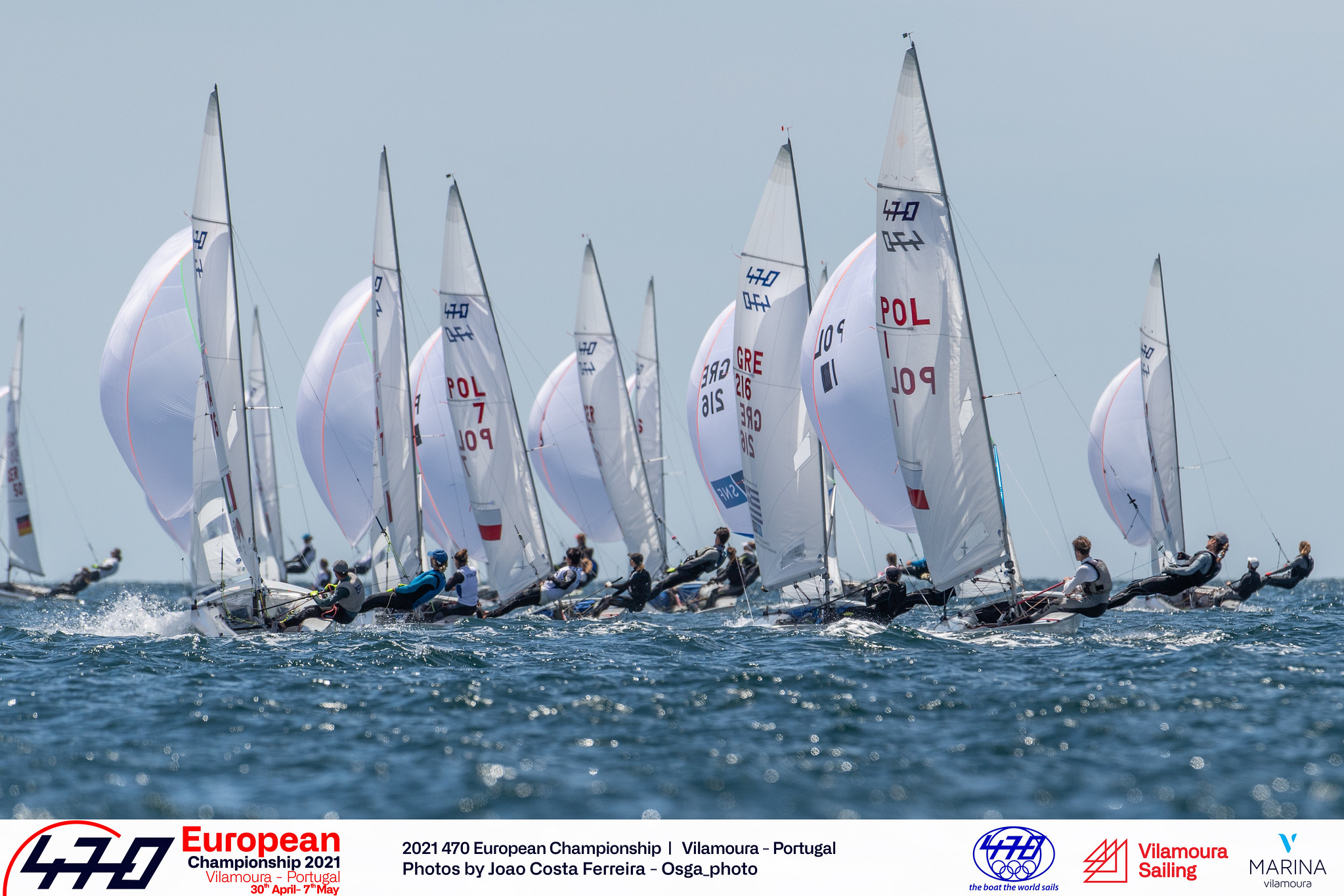
2021 Europeans Vilamoura POR
- All video galleries
- News + Views
- Youth Pathway
- 470 IN 2024
- Why Sail 470?
Latest News
- 28 Aug 2024 2024 470 LATVIAN NATIONAL CHAMPIONSHIP CONCLUDED IN ENGURE
- 25 Aug 2024 KEIJU OKADA / MIHO YOSHIOKA WINNERS OF 2024 470 JAPAN NATIONAL CHAMPIONSHIP
- 8 Aug 2024 LARA VADLAU AND LUKAS MAEHR PUT IN THE PERFORMANCE OF THEIR LIVES TO WIN GOLD IN THE MIXED DINGHY
- 16 May 2024 SCHEDULE OF 2025 470 CLASS CHAMPIONSHIPS

470 championships

LATEST RESULTS
2024 470 all japan national championship - 470.
| POS | NATION | HELM / CREW | PTS |
|---|---|---|---|
| 1 | Keiju Okada / Miho Yoshioka | 19 | |
| 2 | Ai Yoshida / Yugo Yoshida | 36 | |
| 3 | Jumpei Hokazono / Tetuya Isozaki | 67 | |
| 4 | Shunsui Oishi / Momona Fukuda | 67 | |
| 5 | Gaio Koizumi / Kotaro Matsuo | 71 | |
| 6 | Koki Yasunaga / Daisuke Matsuyama | 73 | |
| 7 | Kazuho Ishikawa / Takeru Tanakamaruu | 76 | |
| 8 | Ayato Tanaka / Kimihiko Imamura | 77 | |
| 9 | Kaito Ikeda / Ayaka Ito | 84 | |
| 10 | Youki Honda / Benkei Kanou | 110 |
Paris 2024 Olympic Sailing Competition - 470
| POS | NATION | HELM / CREW | PTS |
|---|---|---|---|
| 1 | Lara Vadlau / Lukas Maehr | 38 | |
| 2 | Keiju Okada / Miho Yoshioka | 41 | |
| 3 | Anton Dahlberg / Lovisa Karlsson | 47 | |
| 4 | Jordi Xammar Hernandez / Nora Brugman Cabot | 49 | |
| 5 | Diogo Costa / Carolina Joao | 53 | |
| 6 | Camille Lecointre / Jeremie Mion | 56 | |
| 7 | Nitai Hasson / Noa Lasry | 67 | |
| 8 | Yves Mermod / Maja Siegenthaler | 68 | |
| 9 | Nia Jerwood / Conor Nicholas | 74 | |
| 10 | Henrique Duarte Haddad / Isabel Swan | 84 |
2024 470 Junior European Championship - 470
| POS | NATION | HELM / CREW | PTS |
|---|---|---|---|
| 1 | Roy LEVY / Ariel GAL | 53 | |
| 2 | Manon PENNANEAC'H / Pierre WILLIOT | 60 | |
| 3 | Lomane VALADE / Julien BUNEL | 61 | |
| 4 | Agnieszka PAWLOWSKA / Bartek SZLIJA | 63 | |
| 5 | Efe TULÇALI / Defne DANIŞMEND | 63 | |
| 6 | Neus BALLESTER BOVER / Alejandro DEMAQUA | 70 | |
| 7 | Catharina SCHAAFF / Colin LIEBIG | 76 | |
| 8 | Zofia KORSAK / Mikołaj BAZYLI | 78 | |
| 9 | Laura PUKROPSKI / Thorben SCHLÜTER | 81 | |
| 10 | Kaito IKEDA / Ayaka ITO | 86 |
- Upcoming events

2024 US Nationals
Rya olympic classes national series.

Sail Melbourne 2024
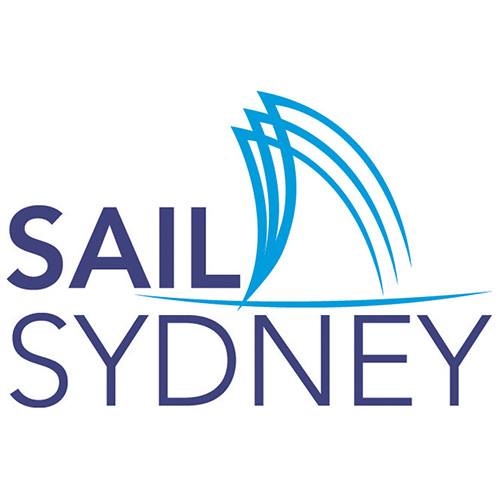
Sail Sydney 2024

Sail Brisbane

2024 470 World Championship

2024 470 European Championship
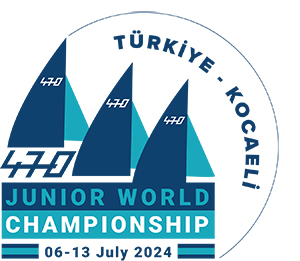
470 Junior World Championship 2024

2024 Open European Trophy & Master's Cup

2024 470 Junior European Championship
World rankings.
| 1 | Jordi Xammar / Nora Brugman | 869 | |
| 2 | Keiju Okada / Miho Yoshioka | 837 | |
| 3 | Camille Lecointre / Jeremie Mion | 818 | |
| 4 | Matisse Pacaud / Lucie De Gennes | 758 | |
| 5 | Giacomo Ferrari / Alessandra Dubbini / Bianca Caruso | 750 | |
| 6 | Anton Dahlberg / Lovisa Karlsson | 749 | |
| 7 | Nitai Hasson / Noa Lasry | 740 | |
| 8 | Lara Vadlau / Lukas Mähr | 721 | |
| 9 | Malte Winkel / Anastasiya Winkel | 718 | |
| 10 | Vita Heathcote / Chris Grube William Heathcote | 672 |
Beyond the 470

FOLLOW US ON FLICKR

2020 OLYMPIC GAMES

2020 World Cup Series

FOLLOW 470 SAILING


IMAGES
VIDEO
COMMENTS
The 470 is a double handed, mixed crew Olympic yacht. The 470 is a light and narrow boat (length 4.7m and beam 1.7m with a weight of 120kg), that responds easily and immediately to body movement. The skipper is normally smaller and lighter (1.65m to 1.8m and 55kg to 65kg) and the crew is taller (1.75m to 1.85m yet only 65kg -75kg).
2 person centerboard class with trapeze. An Olympic class since 1976. Separate events for men and women since 1988. The 470 is sailed in more than 60 countries. Spinnaker: 140 sq. ft. 1 Trapeze.
Cruising World editor Mark Pilsbury reviews the Dufour 470 and the Dufour 61, from one of France's most prolific sailboat builders.
That's plenty to ask of a production boat of this size and price, and the 470 seems to answer those demands nicely. She also comes with a devoted support network of owners. Contact- Catalina Yachts, 818/884-7700, www.catalinayachts.com. Darrell Nicholson.
The 470 is an Olympic Class Dinghy recognized by World Sailing. Sailed by both men and women, it was designed in 1963 by the Frenchman André Cornu as a modern fibreglass planing dinghy. It is a popular class of dinghy, offering a good introduction to high-performance boats without being excessively difficult to handle.
470 is a 15′ 5″ / 4.7 m monohull sailboat designed by Andre Cornu and built by Fountaine Pajot, MacKay Boats Ltd., Parker Yachts, Nautivela, and Mader Bootswerft starting in 1963.
470 (dinghy) The 470 (Four-Seventy) is a double-handed monohull planing dinghy with a centreboard, Bermuda rig, and centre sheeting. Equipped with a spinnaker, trapeze and a large sail-area-to-weight ratio, it is designed to plane easily, and good teamwork is necessary to sail it well. The name comes from the boat's length of 470 centimetres (4 ...
Here are the 2022 data for our research on the average cost of buying and owning a sailboat.
The 470 is an Olympic Class Dinghy recognised by ISAF. Sailed by both men and women, it was designed in 1963 by the Frenchman André Cornu as a modern fibreglass planing dinghy. The name is the overall length of the boat in centimeters (the boat is 4.70 metres long). The hull is fiberglass with integral buoyancy tanks.
Find Catalina 470 boats for sale in your area & across the world on YachtWorld. Offering the best selection of Catalina boats to choose from.
2016 Gold medalist and North Sails expert Sîme Fantela answers your questions about sailing the 470 Who sails the 470? The International 470 has been an Olympic double-handed class since 1976, with separate men's and women's divisions since 1988. Today most sailors are full-time Olympic hopefuls, and because the boat i
Annapolis may be the sailing capital of America, but if you looked around the United States Sailboat Show last fall, you would have no choice but to conclude most sailboats are now built in Europe. The Dufour 470 is a good example of a modern French performance cruiser.
Find Dufour 470 boats for sale in your area & across the world on YachtWorld. Offering the best selection of Dufour boats to choose from.
15.5 foot 470 Olympic class sailboat for sale. Manufactured in 1973. Includes main, jib, and spinnaker with spinnaker pole and trapeze harness. Recently renovated. Good condition. Includes galvanized trailer. Have PA title for trailer and PA registration for the boat.
About US 470 Class Association Olympic equipment of choice for the men's and women's two-person dinghy - representing the world of two-person spinnaker sailing at the Olympics. The 470 has been raced at every Olympics since 1976. In 1988, a women's event was added. For the 2024 Olympics, the 470 will revert to mixed.
The average price of used sailboats is $278,000 ($67,000 to $555,000). Maintenance costs are on average $2,000 - $3,000 per year, and the average total annual cost is $3,000 to $7,000. Of course the price of a sailboat depends on our choices. We decide whether sailing is a rich man's game, or actually a very good holiday investment.
Sailboat Cost Calculator With this calculator, you can quickly calculate your ownership cost based on up-to-date sailboat price data from our yearly research.
Use 470 Groups on Facebook or even Facebook Marketplace to sell your 470 equipment or search for new kit. You can upload and manage your adverts yourself, once you join the two groups. Free Buy and Sell Marketplace. The Int' 470 Class Assocaition encourages everyone to post all information on the following two groups on Facebook.
What is the average cost of buying and owning a sailboat? This comprehensive guide will help you understand the realities of buying and owning a sailboat.
Welcome to the USA 470 Class Association! The story of the 470 - still the best boat to bring sailing to…
Free Classified Ads for the 470 Sailboat. Post your for sale, wanted, or crew request ads here.
Hull length: 13.99m / 45.9ft Reported sail area = main + 106% genoa. OptionL 75HP engine. Available in three versions: Easy, Ocean and Performance. The difference is in the deck layout. Photo above is of the Ocean version.
LARA VADLAU AND LUKAS MAEHR PUT IN THE PERFORMANCE OF THEIR LIVES TO WIN GOLD IN THE MIXED DINGHY 16 May 2024